
The Ultimate Guide to Luggage Sizes: What Size Should You Get?
We use affiliate links, and receive a small commission if you make purchases through them. Find out more here .

Unlock the Ultimate Guide to Airline Luggage Allowances
Don’t get caught off guard by unexpected baggage fees! With this comprehensive eBook, you’ll have all the information you need at your fingertips.
You have successfully joined our subscriber list.
Did you know that choosing a suitcase (or multiple cases, for that matter) in the right size can save you some money in luggage fees and help you become a more organized traveler?
On one end, unused space in your luggage will result in wrinkled clothes and a messy suitcase. Not to mention the extra weight and possible luggage fees. And on the other – having too little space will limit your packing capacity. That’s why nailing the correct luggage size is very, very important.
In this guide, we’ll tell you everything you need to know about all the different luggage sizes, restrictions, and more, so you can understand what size luggage is better for you. Make sure to check out our FAQ section at the bottom if you still have any questions!
Luggage Size Chart
But before we begin this article, down below you can check out our infographic and table with the most common luggage sizes, which will offer an easier way to grasp the differences between them.
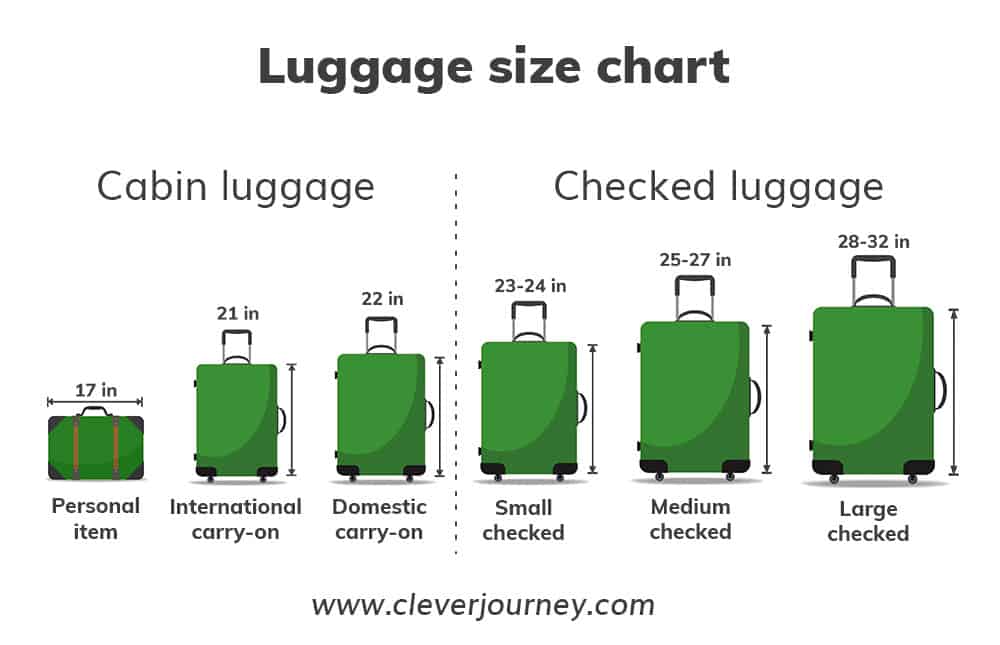
Measuring Luggage
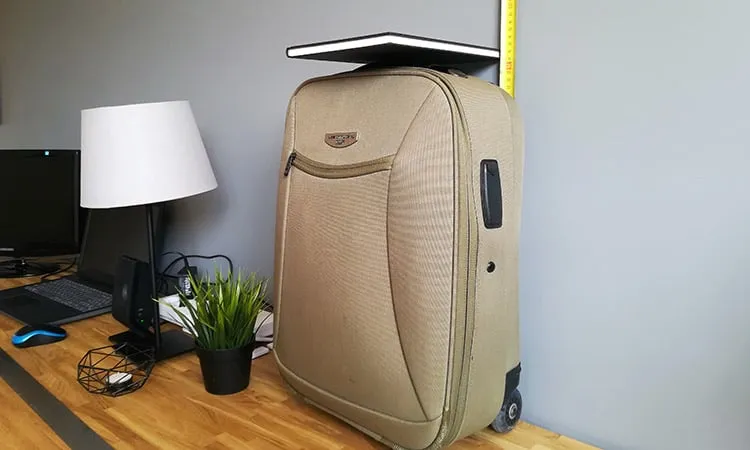
Basically, each airline has different size and weight restrictions for hand and checked luggage. Usually, premium airlines will allow slightly larger bags, and cheaper ones will allow smaller ones with tighter weight limits. Your job as the passenger is to find out the restrictions yourself because they change all the time, and it would be impossible for us to list and update each airline individually.
There are two types of size restrictions that you need to know. The first one is dimensions – height (top to bottom), width (side to side), and depth (front to back). It will usually be applied for personal items and carry-ons and could be stated as follows: 55 x 35 x 25 cm (22 x 14 x 9 inches). Airlines will usually offer measuring boxes inside airports, where you can put in your bags to check if they fit.
The second measurement is linear inches. Linear inches just means the total sum of height, width, and depth, and it’s mainly used for checked luggage, which needs to be under 62 linear inches. So to get linear inches, measure the height, width and depth individually and add them all up.
To measure the dimensions of your suitcase, you can place it next to a wall and measure the height, width, and depth by placing a measuring tape next to the wall. To get a more exact measurement, you can place a book or something flat on the other end of the measuring tape. Make sure to include the wheels, handles, and anything else that’s sticking out! Another thing to keep in mind is that fabric suitcases might become a bit larger once they’re packed to the brim, so before measuring, pack your suitcase full and measure in the widest end.
Hand Luggage
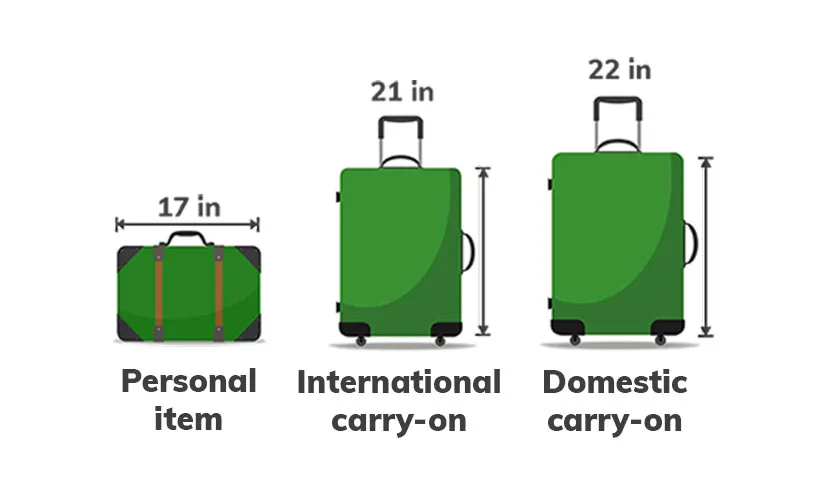
Hand luggage means all the bags that you’re allowed to take with you on the plane without checking them in. Usually, it’s a carry-on, a personal item, and any other items that aren’t counted towards the allowance, such as duty-free items .
Hand luggage has to be stored under each passenger’s front seat or in the overhead compartments, which are located above each seat. You won’t be able to access it during take-off and landing because they have to be tucked away securely in case of an emergency.
When you arrive at the airport, you won’t need to go to the check-in desks if you have just hand luggage, and you’ve already printed your tickets back home. You’ll be able to go straight to security , where TSA (Transport Security Agency) will screen your hand luggage for any prohibited items. After that, you’re free to do duty-free shopping or wait at the designated gate until boarding starts.
Carry-on Luggage vs Personal Items
The main difference between carry-on luggage and personal items (other called “underseat luggage”) is that carry-ons need to be stored in the slightly-larger overhead compartments and personal items under each passenger’s front seat. Usually, most people choose smaller rolling suitcases as their carry-ons and backpacks, duffels, or tote bags as their personal items. That said, you can use any type of bag as a carry-on or a personal item, whether it’s a briefcase, rolling suitcase, duffel bag , backpack, tote, or even a regular shopping bag.
You won’t really be able to access stuff from your carry-on during the first and last 15-30 minutes of the flight, as well as any turbulence, so pack your most necessary items in your personal item, such as your laptop , headphones, e-reader , any medicine, e.t.c.
Personal Item Size and Weight Requirements
Most airlines won’t specifically mention an exact size requirement for personal items, and instead, they’ll just say that it has to fit under the front seat. On average though, it should be 6-9 inches in width, 10-14 inches in height, and 17-18.5 inches in length . They avoid stating the exact measurements because each airline has different types of aircraft in their fleet and each aircraft has a different amount of space under each seat. To get the exact personal item size requirements, you should probably ask the airline directly, or check our list where we compiled personal item restrictions for most popular airlines .
Some airlines also have individual weight restrictions for personal items. But most of them just have some kind of weight limit for the total weight of your personal item and carry-on.
Tip: Looking to purchase a personal item? Check out the Matein Travel laptop backpack , which I’ve used as my personal item on multiple flights without any issues. It always fits under the front seat and it’s surprisingly spacious.
Carry-on Size and Weight Requirements
On average, carry-ons usually have to be 8-10 inches in width, 13-15 inches in height, and 19-23 inches in length. Each airline has different carry-on size requirements, however, the most popular one is 22 x 14 x 9 inches . The restrictions are so different between airlines because the overhead compartments tend to differ in capacity across different aircraft.
In terms of weight, each airline has different weight requirements for carry-on luggage. Most airlines in America don’t have any weight requirements for hand luggage but some do, especially budget airlines. If the airline has a carry-on weight limit, it’s usually between 15-35 lbs (7-16 kg) . Some airlines will also have a specific weight limit for the total weight of carry-ons and personal items.
Tip: Looking for a new carry-on? I’ve used the Travelpro Maxlite 5 19-inch fabric carry-on for a while now and I love it. It’s spacious, lightweight, and very durable. Even though it’s slightly over the limit in width, I’ve never had any issues with that on international flights.
Domestic Carry-Ons vs International Carry-Ons
When you’ll be shopping for a new carry-on, you’ll notice that some of them will be marked as “international carry-on” and some as “domestic carry-on.” That’s because carry-on size restrictions are usually stricter for international flights and looser for domestic ones. If you’re flying domestically, you might get away with a 23-inch (longest side) carry-on, but on an international flight, you’ll probably be limited to 19-21 inches.
So essentially, domestic carry-ons will be slightly larger than international ones. If the carry-on is too large , you will be asked to check it in, and you’ll have to pay additional fees. That’s why it’s important to buy a smaller carry-on if you’re planning on flying internationally. Usually, international carry-ons will have to be under 22 x 14 x 9 inches .
Hand Luggage Fees
Almost all airlines will allow bringing one personal item completely for free. When it comes to carry-ons though, most airlines allow bringing one for free, but budget airlines might charge a fixed fee depending on your class, which could be anywhere from 10$ to 50$. For instance, Spirit airlines will charge 31-50$ for carry-on luggage and Ryanair will charge about 6-20 EUR.
Keep in mind that most of these items are usually allowed for free in addition to other hand baggage:
- Assistive devices for the disabled
- Other wearable clothes
- Walking canes
- Food in disposable containers meant to consume on the airplane
- Child restraint seats
- Duty-free items
- Reading materials
- Cameras ( some airlines consider cameras as personal items, while others don’t. )
- Pet carriers ( Some airlines consider pet carriers as personal items, while others don’t. )
Read Next : 12 Best Underseat Bags Without Wheels in 2022
Hand Luggage Advantages and Disadvantages
Using only hand luggage and avoiding checked luggage altogether is a technique used by many, me included because it offers many benefits:
- No need to wait in line at the check-in counter
- Most of the time, completely for free
- Less likely to be stolen or lost because it’s on you at all times
- Easier to carry around, especially if you use a backpack as a personal item together with a carry-on suitcase
- The best place for keeping valuables and fragile items
- You can access all of your items during the flight
- Less likely to break because it isn’t exposed to baggage handling
However, there are some drawbacks to using only hand luggage, such as:
- Less packing space
- Harder to manage for families because they usually need to bring more items
- It needs to be lugged around the airport after security instead of being handed over at the check-in desks
- Usually, has much stricter weight limits
Tips for Buying Hand Luggage
- If you’re flying on short flights, consider using only an underseat rolling suitcase or backpack. People who fly for business often only need to fly out domestically for a quick meeting, so a lot of them travel with only a personal item. You can easily fit a spare shirt in there as well as some toiletries and a laptop, which is really all you need.
- For up to two-week vacations, a carry-on and a personal item offer more than enough space. Personally, I’m a light packer, and I can travel for up to three weeks or even a month using only a carry-on and a personal item. For most people, this offers enough space.
- Consider getting a backpack with a back strap as your choice of personal item. That way, you can secure it around the retractable handle on top of your carry-on, which makes it incredibly easy to lug around. Especially in crowded areas, such as public transport and airports.
- If you’ll be flying internationally, get a carry-on under 22 x 14 x 9 inches with wheels and handles included. On domestic flights, you’ll probably be able to use something larger, but if you want to avoid paying extra fees down the line, make sure your carry-on is under this limit.
- Make sure to get lightweight hand luggage. The weight restrictions are pretty strict as it is already, so make sure to get a lightweight carry-on and personal item. Especially the carry-on, because you’ll have to stow it in the overhead compartments. So instead of going with a hardside carry-on, get a fabric one instead, which will most likely be lighter.
Read Next: Airport Travel Terminology 101 – The Ultimate Guide
Checked Luggage
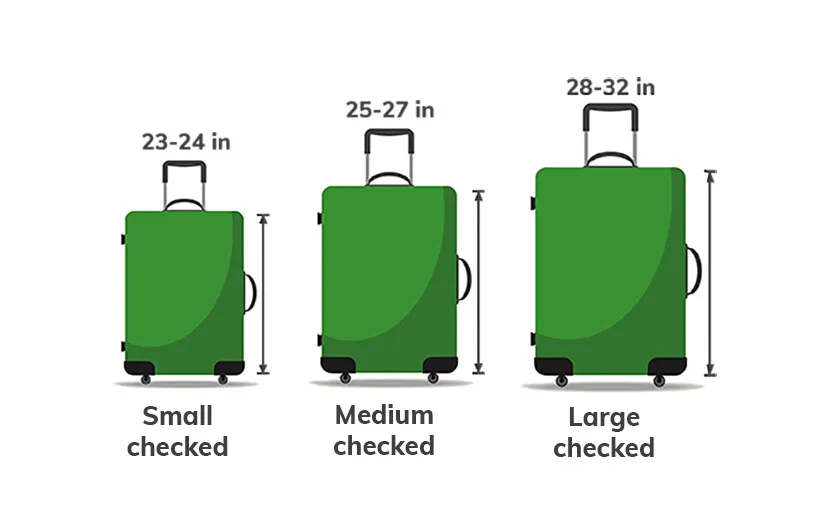
Checked luggage is all baggage that’s too large or too heavy to be carried on the flight, and has to be checked in instead. This means that you’ll need to hand it over at the check-in counters at the airport. The baggage will then be transferred over to baggage handling and it will be loaded in the cargo hold of the airplane . When you land, you’ll have to pick up your checked luggage from the luggage conveyor belts in the baggage reclaim area.
You can use other kinds of baggage as well for checked luggage, not just suitcases. You can also use large backpacks, duffel bags, totes, musical instruments in their cases, large trunks, and other oversized items. A lot of times, you’ll have to check in specialty items, such as large musical instruments and all kinds of sporting equipment, such as bicycles, snowboards, golf clubs, e.t.c.
Read Next: What to Put in Carry-on and What in Checked Luggage (Guide)
Checked Luggage Size and Weight Restrictions
Most commonly, checked luggage will have a size restriction of 62 linear inches (height + width + length) and a weight limit of 50 or 70 lbs. These are the IATA guidelines that are enforced in the EU and US which are there to keep the baggage handlers from handling too heavy bags. Oversized and overweight baggage will be accepted, but it will be labeled as oversized/overweight and you’ll have to pay a fee for that unless it’s sporting equipment. For instance, American Airlines will accept oversized bags up to 126 linear inches (320 cm) and overweight bags up to 100 lbs (45 kg.)
Small vs Medium vs Large Checked Luggage
Checked luggage comes in different sizes, and usually, the longest dimension is 23-32 inches long. Depending on the longest side, checked luggage is usually divided into three sizes, which are small, medium, and large. Small checked suitcases usually are 23-24 inches on the longest size, medium ones 25-27 inches, and large ones in 28-32 inches. Quite often, suitcases above 30 inches will actually be oversized, because they’re over 62 linear inches with wheels and handles included.
For most people, a medium checked suitcase will be the best option, because it will be just within the checked luggage size limits and offer a large amount of space for all of their items.
Read Next: 8 Best 62-Inch Checked Suitcases in 2022
Checked Luggage Fees
On most international flights, airlines will allow you to bring one or two checked bags completely for free. On domestic flights, usually, they’ll offer either one free checked bag or none at all. This depends a lot on the airline though. Additional bags will cost on a per-bag basis, starting with cheaper rates and continuing with more expensive ones. For instance, for American Airlines on domestic flights, the first checked bag will cost 30$, the second 40$, and the third one 100$ .
If you aren’t flying alone and you’re carrying a lot of checked bags, it’s usually a better idea to split them evenly among all the passengers to save some money on the checked baggage fees. It also isn’t advisable to bring more than two checked bags because the fees start to get pretty costly after that.
The fees for overweight and oversized luggage can get very expensive, upwards of 100-200$ for each bag, so before you arrive at the airport, make sure that each bag is under the weight limit.
Checked Luggage Advantages and Disadvantages
Although there are a lot of disadvantages for flying with checked luggage, there are some advantages as well, such as:
- Checked bags offer much more space
- Better for families who carry a lot of items
- Checked bags don’t need to be carried around the airport after checking them in
- No need to worry about size and weight, as the restrictions are pretty hard to reach
- You should be able to get away with a slightly oversized checked bag because they’re rarely measured
However, there’s a reason why I don’t travel with checked luggage. In my opinion, it has more disadvantages, such as:
- With a personal item, carry-on, and a checked suitcase, it’s much more difficult to use public transport
- Checked luggage is mostly a paid service, especially with budget airlines
- There’s just too much space if you’re a light packer
- Checked bags can get damaged from baggage handling
- Items get lost or stolen much more frequently when packed in checked luggage
- You won’t be able to access the contents of checked luggage during the whole flight
- In case checked baggage gets lost, you’ll be left without a lot of items and your trip might be ruined
- You’ll have to wait in the check-in line at the airport
Tips for Buying Checked Luggage
- Avoid plastic checked suitcases. Hardside ABS, Polycarbonate, or Polypropylene suitcases can crack pretty easily. When they’re thrown in the baggage area under a pile of other suitcases, this can happen very easily. That’s why you should choose an aluminum checked suitcase or a fabric one, which will be much less likely to break.
- Before buying a checked suitcase, double-check that it’s below 62 linear inches. Oversized checked luggage fees can get pretty expensive, usually between 100-200$. To avoid this hefty fee make sure that your suitcase is below 62 linear inches (height + width + depth) with handles and wheels included. A very large amount of large checked suitcases, in fact, about 50-80% of them are oversized, so pay close attention to the dimensions.
- A medium checked suitcase (25-27 inches) is more than enough for most people. Usually, medium checked suitcases are 58-61 linear inches in size, which is just below the 62 linear inch size limit, so when you’re looking for a checked suitcase, get one in this size.
- Get a bright or patterned checked suitcase. Checked luggage gets lost much more frequently. So when you’re shopping for a new case, make sure to get one that’s colorful and easy to recognize . It will be much easier to spot on the baggage carousel and if it gets lost, the chances of finding it will be much better because you’ll be able to describe it better. If you already own a dark checked suitcase, get a colorful patterned luggage cover .
- Avoid checked luggage with spinner wheels. Rolling, inline (2 wheels) suitcases are better options for checked suitcases because they’re much less likely to break while the bag is checked in. Spinner wheels are much more likely to fall off because they’re extended out from the main shape of the suitcase. It’s actually one of the most common things that break on checked bags.
- Consider getting a pelican trunk instead of a typical checked suitcase. They’re basically indestructible and they’re one of the most popular choices for climbers, camera crews, and other people who need to bring a lot of expensive checked gear.
What Size Luggage Should You Get?
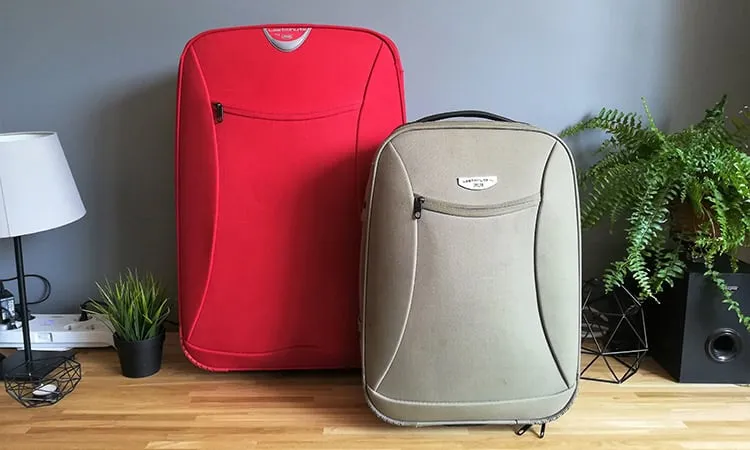
There are all kinds of different factors that determine what kind of suitcase you should get. Before buying any luggage, you should understand how often and where you’ll be traveling, how many people you’ll be flying with, what are your packing traditions, and so on.
Are You an Over-Packer?
There’s nothing wrong with being an over-packer, but it will affect what kind of luggage you should choose and how much you’ll be paying in fees. Most over-packers like to travel with a checked suitcase and a personal item, such as a small backpack, skipping the carry-on entirely. You’ll be able to pack your valuables and essentials in the personal item and be left with a very large amount of space in your checked suitcase, where you can pack all of your clothing and anything else you’d need. A medium checked suitcase will usually offer about 90-100 l of space while a carry-on only 35-50 l, so the difference is pretty significant.
How Long You’ll Be Traveling?
The length of your trips/vacations also determines what kind of luggage you should get. If you’ll be traveling for months, unless you’re an extreme minimalist, you’ll need to bring some kind of checked luggage. But for two to three-week trips, it’s perfectly fine to bring only a carry-on and a personal item, unless you’re an over-packer or you need to bring other kinds of gear for your job, planned activities, e.t.c.
Where You’re Flying to and What Are Your Planned Activities?
Think about what you’ll be doing and what gear you’ll need. Do you need scuba diving or skiing gear? Are you into photography and need to bring a large tripod? Are you flying to a cold-weather country and you need to bring a lot of extra warm clothing? The kind of travel that you’ll be doing, determines what size luggage you should get.
Think about valuable and fragile gear specifically. Try to keep the most valuable items in your hand luggage. If that isn’t possible, remember to ensure your gear and invest in a durable, large enough, checked suitcase or trunk. A good option for that is the pelican trunk , which is the industry standard for professionals.
Tip: It’s Better to Buy a Smaller Suitcase, Instead of a Larger One
Many people will probably disagree but I personally think that it’s always a smarter choice to buy a smaller suitcase instead of a larger one. This will make you become a lighter packer, which could end up saving you some money in the long run on checked baggage fees.
A lot of times, people are bringing gear that they don’t really need and end up with heavier, oversized suitcases. Remember that you’ll also have to carry your luggage around the town and to the airport. You’re on a vacation to get new experiences, not buy a lot of unneeded stuff, and be exhausted from carrying an oversized suitcase. Of course, if you’re traveling for work, that may not be true, but for general leisure travel, it’s a better idea to get a slightly smaller suitcase than you think you’d need.
What Size Luggage I Use Personally
I usually travel one or two weeks at a time, so a personal item (backpack) and an international carry-on are more than enough to fit in everything that I need. I rarely use checked luggage because I’m a minimalistic packer.
My favorite has become the B06XZTZ7GB ?tag=cleverjourney-general-th-20&linkCode=ogi&th=1&psc=1′ title=’Matein laptop backpack’ target=’_blank’ rel=’nofollow noopener sponsored’ data-aawp-product-id=’ B06XZTZ7GB ‘ data-aawp-product-title=’Matein laptop backpack’>Matein laptop backpack for a personal item, which fits perfectly under the front seat and has many neat compartments for everything that I need. It’s 18 x 12 x 7.8 inches large, but I never pack it full, so it always fits under the front seat.
And for the carry-on, I use the B07BM9DFX9 ?tag=cleverjourney-general-th-20&linkCode=ogi&th=1&psc=1′ title=’Travelpro Maxlite 5 International 19-inch carry-on’ target=’_blank’ rel=’nofollow noopener sponsored’ data-aawp-product-id=’ B07BM9DFX9 ‘ data-aawp-product-title=’Travelpro Maxlite 5 International 19-inch carry-on’>Travelpro Maxlite 5 International 19-inch carry-on , which is pretty light and small enough for domestic luggage restrictions. It’s 21.75 x 15.75 x 7.75 inches large with wheels and handles included, so sometimes it’s a little bit above international limits, but I’ve never had any issues with it. I’ve tried squeezing it inside the measurement boxes myself, and I managed to fit it in with a tight squeeze.
My laptop backpack has a rear strap that wraps around the carry-on’s retractable handle so my backpack can be secured on top of it. It’s handy because my carry-on has spinner wheels, and it’s super easy to move around. In tight spaces, for instance, in the subway, it’s much easier to store the backpack on top of the carry-on.
If you’re a light packer like me, I’d suggest going with a backpack and a carry-on. It’ll be enough for 1-2 week trips, but if you wash some clothes midway and don’t buy too many souvenirs, you can stretch that to three weeks or even a month. If you’re traveling longer than that or you’re an over-packer, you should get a 25-27-inch medium checked suitcase instead of the carry-on.
Also check out: Airplane seat upgrades
Frequently Asked Questions About Luggage Sizes
What’s the largest luggage size for checked-in luggage ( 62-inch luggage ).
In order to comply with the 62-linear-inch checked luggage size requirement, you shouldn’t get a suitcase larger than 29-30 inches (longest side.) Almost all 31 and 32-inch suitcases will be oversized. Even a lot of 28-30-inch suitcases are oversized, so you have to double-check the product description and find out how large they really are. Count the total sum of the height, width, and depth, with wheels and handles included to get the true linear-inch measurement. The largest suitcases within the 62-linear-inch restriction are about 100-120l in volume.
To maximize the amount of space that you can have inside, choose a fabric suitcase, which will open from the top, instead of the middle, as you see on most hardside cases. This means you’ll have a larger main compartment. Also, make sure to get it with inline rolling wheels, instead of spinner ones, which results in a lot of unused space.
Tip: If you want to maximize the amount of space you get from a 62-linear-inch checked suitcase, get the Pelican 1615 travel case , which is exactly 62 linear inches in size and is virtually indestructible.
What’s the largest size for hand luggage?
When we talk about hand luggage, there are different restrictions for personal items and carry-ons. There are also different restrictions for each airline. In general, personal items should be below 17 x 10 x 7 inches in dimensions and carry-ons under 22 x 14 x 9 inches.
The largest size restriction for personal items that we found was on Southwest airlines, where personal items need to be under 18.5 x 13.5 x 8.5 inches. The largest size restriction for carry-ons was on Alaska Air, which was 24 x 17 x 10 inches. Generally, more expensive airlines will have looser restrictions for hand luggage.
What are the 3 luggage sizes?
If we’re talking about dimensions, the three luggage sizes are height (from top to bottom), width (from side to side), and depth (from front to back).
If, however, we’re talking in terms of luggage types, what people most likely mean with the 3 luggage sizes is personal items, carry-ons, and checked luggage, which have three different size and weight restrictions.
What’s the best luggage size for 20 and 23 kg?
The most common weight restriction for checked luggage on budget airlines is 20 or 23 kg (44 or 50 lbs). The best luggage size for this weight restriction is between 25-29 inches (longest size) . That’s because 20 or 23 kg checked luggage has to be under 62 linear inches (157 cm). You can calculate the linear inches by adding up height, width, and depth. Most suitcases above 29 inches will be over this limit, which means you’ll have to pay oversized baggage fees. You should always include the wheels and handles in these measurements.
Can I use backpacks and duffel bags as hand/checked luggage?
Yes, you can use backpacks and duffel bags as checked luggage. Theoretically, you can use any type of bag as checked luggage, as long as it’s durable enough to withstand baggage handling. You could even use a cardboard box , although it may not be a wise idea.
Personally, I’ve only traveled with a large backpack as my checked luggage. That’s because I do a lot of hiking and my hiking backpack is much larger than a carry-on. It’s pretty common for people to travel only with a large backpack (not only hike) and keep their essentials in a plastic bag or a tote bag during the flight. This gives you a lot of freedom because everything you need is packed inside one large backpack.
Do I need to include wheels and handles when measuring luggage?
You always need to include wheels, handles, and other elements that are sticking out when measuring luggage. A lot of people don’t know this and they end up purchasing oversized luggage, only to regret it later. You also need to take into account that if you’re buying an expendable suitcase, it will become a few inches wider when expanded.
What size luggage should I use for a week-long trip?
For a week-long trip, everyone should be able to fit everything they’d need in a carry-on and a personal item. Some people struggle with over-packing and end up using checked luggage for week-long trips, which can be avoided with smarter packing choices. When packing for your trip, always lay everything out and re-evaluate each individual item individually. Ask yourself if you’ll be using these items on your trip. And if the answer is “Maybe” you should leave that specific item at home. Personally, I can fit everything I’d need for 2-4 weeks in a single carry-on and a personal item.
What if my checked luggage is oversized?
IATA, which is the largest worldwide airline regulator, states that checked bags can’t be over 62 linear inches in order to keep the baggage handlers from working with oversized bags. Anything over 62 linear inches will be labeled as “oversized” and will cost you an extra 100-200$, depending on the airline.
Even if you pay the hefty oversized luggage fees, there is a limit to how large checked luggage you can bring. Each airline considers this individually, and, for instance, American Airlines will allow oversized bags up to 126 linear inches (320 cm).
The rules are slightly different for sporting equipment, though. Bicycles, for instance, will almost always be allowed, even if they’re oversized, and their luggage fees won’t be as expensive.
What if my checked luggage is overweight?
Overweight checked luggage is allowed, but will be marked as overweight and will cost an additional 100-200$, depending on the airline. IATA states that checked baggage can’t weigh over 70 lbs (31 kg), to protect the baggage handlers from working with overweight items, so anything over that will be marked as overweight. Each airline has a different limit on overweight checked luggage. For instance, American Airlines will allow checked baggage up to 100 lbs (45 kg).
Do carry-on measurements need to be exact?
Unfortunately, carry-on measurements need to be exact. Most airlines have measurement boxes inside airports, which are in the exact measurements of their restrictions. If your carry-on looks oversized, they’ll ask you to put it inside the measurement box. Carry-on suitcases aren’t really flexible, so you won’t be able to get away with an oversized carry-on. If, on the other hand, you’re using a duffel bag or a backpack as your carry-on, then you might get away with a slightly oversized bag, as you’ll be able to squeeze it inside the measurement box.
Should I get hard or soft luggage ?
There are pros and cons for both, but I personally tend to lean towards fabric luggage. It’s lighter, less likely to crack or break, and you can extend it slightly outwards if you’ve over-packed. On the other hand, hardside luggage offers more protection to your items and is better-looking in my opinion. Modern hardside suitcases made from Polycarbonate are also pretty durable and don’t weigh much more than comparable fabric alternatives. So it doesn’t really matter that much whether you choose a hardside or softside bag – it’s more a matter of preference.
The only real instance where I wouldn’t use a hardside plastic suitcase is in checked luggage. They’re put under a lot more pressure from baggage handling and quite often, they get thrown around and placed at the bottom of a pile of checked suitcases. They’re much more likely to each up with cracks or dents, so using a fabric-checked suitcase would make more sense.
Should I get a rolling or spinner suitcase ?
There are advantages to both, but generally, it’s better to stick with spinner suitcases for carry-on luggage and rolling ones for checked luggage. That’s because while spinner suitcases are much easier to move around, they’re much easier to break off the suitcase. And in checked luggage, they’re much more likely to break off from luggage handling.
Rolling suitcases will usually be more spacious because the wheels are somewhat integrated within the main frame. On spinner suitcases, they’ll extend outwards of the suitcase, which results in a lot of unused space underneath the suitcase. Remember that the wheels are counted towards the total measurements.
But if you’re having back problems or in general lugging around a suitcase gives you hard time, then a suitcase with spinner wheels might make more sense. Compared to inline rolling suitcases, they’re much, much easier to move around – they practically roll by themselves.
How much luggage can I bring on international flights ?
Most airlines will allow one personal item and one carry-on for free on international flights. As for checked luggage, most airlines will allow one or even two checked bags for free for each passenger, and the rest will need to be paid for with additional fees, ranging from 30-100$. In general, the fees increase for each next checked bag and could be as follows: 30$ for the first checked bag, 40$ for the second, and 100$ for each next one.
You’ll be able to bring up to 10 checked suitcases (even though it’ll cost a small fortune!) but on some international destinations, a bit less. Airlines operate within the rules set by airline regulators, and in some countries, each passenger can have only two or three checked bags.
How many pieces and what size should a luggage set be?
Most luggage sets come in three pieces: one carry-on (19-23 inches), one medium checked suitcase (25-27 inches), and one large checked suitcase (28-32 inches). I would advise against getting a 3-piece luggage set like this because quite often, the largest piece in the set is oversized, which means that it’s above the 62 linear inch limit and you’ll have to pay oversized luggage fees.
Instead, it would be much more beneficial to get a 2-piece set containing a carry-on and a medium checked suitcase, or a 3-piece set that also contains a personal item (underseat bag). If you’re getting a 3-piece set with a large checked bag, make sure that it isn’t oversized.
Luggage sets are often cheaper to get than buying each piece individually, so it’s quite often a smarter choice to buy a whole set.
Final Words
Getting the right size luggage is really important because if it’s oversized, you might end up paying extra in fees, or just end up with a lot of unused space. For anyone new to traveling, I’d advise getting a small backpack as a personal item and a carry-on that’s within 22 x 14 x 9 inches. This is more than enough for most trips, and I’m usually able to squeeze in everything needed for 2-4 weeks in there. If you’re an over-packer, you might need to swap that carry-on with a medium checked suitcase, which would be 25-27 inches in size (longest end).
This post is also available in: English
You Might Also Enjoy
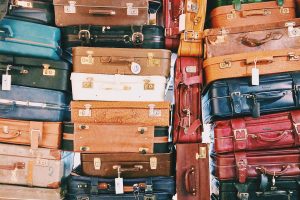
Leave a Reply Cancel reply
Your email address will not be published. Required fields are marked *
Save my name, email, and website in this browser for the next time I comment.
Featured in

GET CONNECTED
Follow Clever Journey on social media for travel tips, packing hacks, and latest updates!
SUB TO NEWSLETTER
Subscribe to our newsletter to get the latest travel tips, packing hacks, gear reviews, and bargain deals straight to your inbox. We hate spam, so we’ll send only the most important stuff.
Protect Your Trip »
Carry-on luggage and personal item size limits (2024).
Just like checked bags, carry-on luggage size restrictions can vary by airline.
Carry-on Luggage Sizes by Airline

Key Takeaways
- The carry-on size limit for many airlines is 22 x 14 x 9 inches.
- Most domestic airlines do not have a weight limit for carry-on bags.
- You can typically bring a carry-on bag in addition to a personal item.
- Your personal item should be able to fit neatly under the seat in front of you.
If you're traveling with carry-on luggage and/or a personal item, you'll need to adhere to size restrictions in the same way you do with checked bags . These rules include the dimensions of your carry-on bag and, in some scenarios, even the weight.
What size luggage is a carry-on?
While carry-on luggage sizes can vary by airline, several major carriers go by these dimensions.
Airlines calculate carry-on luggage size measurements using two methods:
- Height by width by depth: Most – but not all – airlines measure bags by inches or centimeters using this formula: height by width by depth, such as 22 x 14 x 9 inches. (Note: The dimensions listed below, which are given according to that formula, may differ slightly from the way each individual airline formats its size requirements.)
- Linear inches: A few airlines have linear inch restrictions for carry-on baggage, meaning the airline gives one number for the total of all three dimensions. As long as the combined height, width and depth don't exceed that number, you're in the clear.
Can a 24-inch bag be a carry-on?
Yes, a 24-inch bag can be used as a carry-on suitcase when flying with the following airlines: Frontier, Southwest and Sun Country . However, if you're shopping for new carry-on luggage, it's best to opt for something that meets the requirements for most major airlines (22 x 14 x 9 inches or smaller).
Is there a weight limit for carry-on bags?
Most major domestic airlines do not impose a weight limit on carry-on bags; however, several international airlines have weight restrictions for carry-on luggage and, in some cases, personal items.
Carry-on vs. personal item: What's the difference?
A carry-on bag is typically stored in a plane's overhead bin, while a personal item should fit under the seat in front of you. Most airlines allow economy passengers to bring one carry-on and one personal item – such as an underseat bag – at no extra cost.
Carry-on luggage sizes by airline
Click on the major domestic and international airlines below to see their carry-on luggage size restrictions in inches for economy passengers – and note that any handles and wheels on your bags count toward size limits as well.
Domestic Airlines
Alaska airlines, allegiant air, american airlines, delta air lines, frontier airlines, hawaiian airlines, southwest airlines, spirit airlines, sun country airlines, united airlines, international airlines, all nippon airways, british airways, cathay pacific, klm royal dutch airlines, qatar airways, scandinavian airlines, singapore airlines, turkish airlines, virgin atlantic.
See all Alaska Airlines carry-on policies.
The fee is often around $20 if you pay for your carry-on baggage at the time of booking; it costs a hefty $45 if you add a carry-on bag later – and up to $75 at the gate.
See all Allegiant Air carry-on policies.
The above rules also apply to basic economy tickets.
See all American Airlines carry-on policies.
Note that if you're flying to or from Beijing or Shanghai, there is a 22-pound weight limit for a carry-on; for Singapore, there is a 15-pound limit.
See all Delta Airlines carry-on policies.
There are two instances where the carry-on bag fee is waived:
- You're an elite member of the FRONTIER Miles rewards program .
- You bought a specialty ticket like the WORKS bundle.
Also note that carry-on bag fees, which typically start at around $30, depend on your destination, and that prices are cheapest if you add baggage when you make your booking. You'll pay more to add it later, especially if you do so at the airport. Sometimes it's actually cheaper to purchase a checked bag instead of a carry-on.
See all Frontier Airlines carry-on policies.
See all Hawaiian Airlines carry-on policies.
If you booked a Blue Basic ticket, you're only permitted to bring a personal item that fits under the seat in front of you. If you bring a carry-on bag, you will have to pay $65 to check it at the gate (or up to $180 if you've already checked two other bags). However, select customers with Blue Basic fares can bring carry-on bags for free. These include:
- Active U.S. military personnel
- Unaccompanied minors
- Customers flying to London
If you purchase a higher-class seat or if you reach Mosaic status on JetBlue's TrueBlue rewards program , you can also bring a carry-on bag for free on a Blue Basic ticket.
See all JetBlue carry-on policies.
See all Southwest Airlines carry-on policies.
Spirit's carry-on bag fees vary between flights, but they tend to start at around $25 to $30 for U.S. domestic flights. If you need to bring carry-on luggage, it's always cheapest to pay for it when you first book your flight. It will cost you more to add a bag afterward – and at least double the initial fee if you do it at the airport.
See all Spirit Airlines carry-on policies.
The Sun Country Airlines fee for a carry-on bag is around $30 if you pay for it when booking, or more if you add it later.
See all Sun Country carry-on policies.
There's one notable exception for carry-on baggage with United: Passengers with a basic economy ticket can only take one personal item on board – no carry-on bag. This policy applies to travelers flying basic economy domestically or between the U.S. and Canada. If you have a basic economy ticket and are going to Central or South America (including Mexico) or taking trans-Atlantic or trans-Pacific flights, you can bring a full-size carry-on bag.
See all United Airlines carry-on policies.
Aer Lingus' carry-on policy depends on where you're flying. For trans-Atlantic flights, you can bring one carry-on bag within the dimensions above, plus a small personal item for free. If you're flying within Europe on Aer Lingus, the rules are a bit different: You'll have to pay a fee to bring a carry-on with you on board, starting at 5.99 euros. However, you can check that same bag for free.
If you're flying Aer Lingus Regional (a service with smaller planes, flying mostly around Ireland and the U.K.), a smaller carry-on limit applies: 18.5 x 13 x 8 inches, with a weight limit of 15 pounds.
See all Aer Lingus carry-on policies.
All Aeroméxico customers can bring a standard carry-on bag and a personal item on board. Be careful with the weight limit, though: For international flights or basic fare flights within Mexico, these two items combined cannot weigh more than 22 pounds. So, if your carry-on bag weighs 15 pounds, for example, your personal item cannot be more than 7 pounds.
See all Aeroméxico carry-on policies.
While there's no weight limit for carry-on luggage, Air Canada says your carry-on bag should be light enough that it can easily be lifted into the overhead bin. Also note that airport purchases (for example, larger duty-free items) count toward your baggage limit.
See all Air Canada carry-on policies.
Note that both your personal item and carry-on bag (referred to as "hand baggage") combined must not weigh more than 26 pounds if you're traveling economy. The weight limit is 40 pounds for premium economy and other higher-class cabins.
See all Air France carry-on policies.
A variety of personal items (think a handbag and umbrella) are permitted as long as they fit under the seat in front of you; this includes any items purchased at the airport.
See all All Nippon Airways carry-on policies.
If airline staff put a yellow tag on your bag, it should be stored under the seat in front of you.
See all British Airways carry-on policies.
Cathay Pacific has shifted from a weight allowance to a piece allowance, and this policy varies by itinerary. Passengers are generally permitted to bring one carry-on bag plus a small personal item (and assistive devices like a walking stick), but it's best to check your booking carefully to confirm the exact allowance. You're asked to check in any baggage that's too heavy to lift into the overhead compartment.
See all Cathay Pacific carry-on policies.
Since easyJet is a budget airline, standard fares only allow customers to bring one personal item (called a "small cabin bag") aboard for free. Fees for standard carry-on bags are between 5.99 and 32.99 British pounds, depending on your destination and when you add an extra bag to your reservation.
See all easyJet carry-on policies.
The above rules apply to all economy passengers except those traveling from Brazil, whose carry-on luggage can weigh up to 22 pounds. Emirates only allows economy passengers to bring one item on board; whether you bring a carry-on bag for the overhead bin or a personal item to tuck under the seat, this bag must comply with the size limits.
See all Emirates carry-on policies.
Be aware that the 22-pound weight limit applies to both your personal item and carry-on combined. If your flight was booked through Iberia but is operated by Vueling, similar rules apply, but the size limits for your carry-on bags are slightly smaller.
See all Iberia carry-on policies.
If you're traveling on the cheaper Light ticket, you may be asked to check your carry-on bag for no extra cost, if space is limited.
See all KLM Royal Dutch Airlines carry-on policies.
See all Lufthansa carry-on policies.
The above rules apply to LowFare+ customers. Passengers who fly LowFare (comparable to Basic Economy fare) can only bring a personal item (underseat bag) measuring 15 x 11.5 x 7.5 inches.
See all Norwegian carry-on policies.
Qantas
Economy passengers can opt to bring a nonrigid garment bag measuring 45 x 24 x 4 inches (or 73 linear inches) instead of a standard 22 x 14 x 9-inch carry-on bag. The above rules apply to all economy tickets and vary for higher classes on international and domestic flights with Qantas.
See all Qantas carry-on luggage policies.
Qatar Airways allows passengers to bring multiple personal items provided they fit under the seat in front of you. Unlike with other airlines, laptops and laptop bags do not count as personal items and must fit within your main hand baggage allowance. For tickets issued in Brazil, the carry-on weight limit is 22 pounds.
Be careful: Qatar doesn't accept carry-ons longer than 20 inches, which is shorter than many other airlines.
See all Qatar Airways carry-on policies.
Ryanair is a low-cost carrier, so unless you pay extra, you can only bring one small bag that fits under the seat in front of you, per the personal item guidelines above. To bring a larger carry-on bag, travelers need to purchase Ryanair's Priority & 2 Cabin Bags option, which typically costs between 6 and 32 euros depending on your destination.
See all Ryanair carry-on policies.
Tips on Trips and Expert Picks Newsletter
Travel tips, vacation ideas and more to make your next vacation stellar.
Sign up to receive the latest updates from U.S News & World Report and our trusted partners and sponsors. By clicking submit, you are agreeing to our Terms and Conditions & Privacy Policy .
Most (but not all) Scandinavian Airlines fares allow you to bring one traditional carry-on bag, plus a personal item, which SAS calls an "underseat bag." There's one exception: Passengers traveling within Europe on the Go Light fare must pay for a larger carry-on bag. If you booked a Go Light ticket for intercontinental flights, a carry-on bag is included.
See all Scandinavian Airlines carry-on policies.
Singapore Airlines has an unusual method for measuring carry-on bags – the dimensions of the bag must not add up to more than 45 linear inches total. For example, a bag measuring 15 x 15 x 15 inches would be suitable. All passengers can bring one bag of this size, plus a smaller personal item. The personal item, whose dimensions are specified above, does not count toward the 15-pound carry-on limit.
See all Singapore Airlines carry-on policies.
See all Turkish Airlines carry-on policies.
Virgin Atlantic lets every passenger bring a carry-on bag, including children younger than age 2. You can bring a bag weighing no more than 13 pounds for your child, in addition to a collapsible stroller and/or car seat. Each passenger is also allowed to bring a handbag or small backpack, an umbrella, a walking stick and airport purchases. Take note: Laptops do not count as personal items on Virgin Atlantic and should fit into your main carry-on bag. There's no specific size limit on the other personal items, but bags or airport purchases should fit under the seat in front of you.
See all Virgin Atlantic carry-on policies.
Note that the above rules apply to passengers who book a TimeFlex or Premium Fare, as well as anyone traveling with a child under age 2 and/or requiring special assistance at the airport.
See all Vueling carry-on policies.
See all WestJet carry-on policies.
Why Trust U.S. News Travel
Amanda Norcross is a seasoned traveler who packs just one carry-on bag and a personal item – even when adventuring with her toddler . She used her personal experience and research skills to put together this guide, and notes that even if your carry-on bag meets size restrictions, you may still need to check it at the gate because of limited space in the overhead bin. Luckily, it's still free.
You might also be interested in:
- The Best Carry-on Backpacks
- What Is Allowed in a Carry-on?
- What to Pack in a Carry-on Bag
- The Best Travel Insurance Companies
Tags: Travel , Airlines , Travel Tips
World's Best Places To Visit
- # 1 South Island, New Zealand
- # 4 Bora Bora
If you make a purchase from our site, we may earn a commission. This does not affect the quality or independence of our editorial content.
You May Also Like
Best whale watching tours in maine.
Marisa Méndez April 23, 2024

The Best Wineries in Napa Valley
April 23, 2024

The Best East Coast Beaches
April 19, 2024

The Best Carry-on Luggage
Erin Evans , Rachael Hood , Catriona Kendall , Amanda Norcross and Leilani Osmundson April 17, 2024

The Best Hard-sided Luggage Picks

The Best Luggage Brands
Rachael Hood April 17, 2024

The Best Yellowstone National Park Tours
John Rodwan April 17, 2024

The Best Rome Colosseum Tours
Laura Itzkowitz April 17, 2024

Best Alaska Tours
Lyn Mettler April 16, 2024

The Best Fredericksburg Wine Tours

Advertiser Disclosure
Many of the credit card offers that appear on this site are from credit card companies from which we receive financial compensation. This compensation may impact how and where products appear on this site (including, for example, the order in which they appear). However, the credit card information that we publish has been written and evaluated by experts who know these products inside out. We only recommend products we either use ourselves or endorse. This site does not include all credit card companies or all available credit card offers that are on the market. See our advertising policy here where we list advertisers that we work with, and how we make money. You can also review our credit card rating methodology .
Carry-On Luggage Size Chart for 64 Major Airlines [Dimensions, Sizes & More]
Alex Miller
Founder & CEO
290 Published Articles
Countries Visited: 34 U.S. States Visited: 29
Senior Editor & Content Contributor
88 Published Articles 658 Edited Articles
Countries Visited: 41 U.S. States Visited: 28
Keri Stooksbury
Editor-in-Chief
32 Published Articles 3123 Edited Articles
Countries Visited: 47 U.S. States Visited: 28
![total travel size Carry-On Luggage Size Chart for 64 Major Airlines [Dimensions, Sizes & More]](https://upgradedpoints.com/wp-content/uploads/2019/03/AdobeStock_251002131.jpeg?auto=webp&disable=upscale&width=1200)
We may be compensated when you click on product links, such as credit cards, from one or more of our advertising partners. Terms apply to the offers below. See our Advertising Policy for more about our partners, how we make money, and our rating methodology. Opinions and recommendations are ours alone.
Whether you’re flying domestically or internationally, every airline has its own carry-on luggage size restrictions. There is no one-size-fits-all approach, so you need to check your airline’s specific policy before traveling to ensure your carry-on bag isn’t rejected with potential additional charges.
Below, you’ll find a helpful chart detailing the most popular airlines’ carry-on restrictions, including the size and weight of a standard carry-on, and whether this varies due to the cabin you’re traveling in. We’ve also covered checked luggage sizes and allowances , too.
Don’t forget that there are many ways to avoid paying for baggage fees such as carry-ons and that’s what we cover in our in-depth article.
In some cases, you’ll see that the airline has a rule about maximum linear dimensions. That means that, when you add the length, width, and depth of a piece of luggage together, the sum can’t exceed a certain number. For example, if you have a suitcase that’s 28 inches long, 20 inches wide, and 18 inches deep, the linear dimensions would total 66 inches, too big for many airlines.
Carry-On Luggage Size Chart for Major Airlines
Unless specified, the maximum weight allowance is across your standard carry-on luggage and personal item combined.
Frequently Asked Questions
What is considered carry-on luggage.
There’s no industry standard for sizes for carry-on luggage, with every airline assigning their own size and weight restrictions. If you want to purchase a carry-on bag that would be accepted by most airlines, then the most common maximum size would be 22 x 14 x 9 inches (56 x 36 x 23 cm), including handles and wheels.
Which carry-on luggage is best?
The best carry-on bag depends on your own requirements. For example, do you need a wheelie case or a backpack, or a bag with a laptop compartment or built-in security? We’ve rounded up what we consider the best carry-on luggage bags for any traveler , ranging from soft-sided and hardshell wheelies to convenient backpacks.
Is a backpack considered carry-on?
A backpack would be considered a carry-on item if it adheres to the maximum size restrictions of a specific airline. Most airlines have a larger size allowance for a standard carry-on piece and slightly smaller one for a personal item (where permitted).
What is not allowed in a carry-on bag?
For safety reasons, there are certain items that are prohibited to be stored in carry-on luggage. These include individual containers with liquids over 3.4 ounces (100 ml) or a combined amount of liquids over 1 quart (1 liter); sharp objects such as scissors, blades, or pen knives; firearms; sporting equipment such as baseball bats or hockey sticks; tools; and lighters, matches, or other flammable items.
Is there a weight limit for carry-on luggage?
As with size restrictions, there are no industry standards for maximum weight allowances for carry-on luggage. These are defined by each individual airline, with some airlines actually not publishing a specific weight restriction — just that you must be able to lift the bag into the overhead compartment yourself.
It’s also worth checking whether the airline’s stated weight allowance applies just to your carry-on piece or whether it applies to the combined weight of your carry-on and personal item.
What is the difference between a personal item and carry-on?
Many airlines allow passengers to bring a personal item in addition to a carry-on bag. A personal item is usually a smaller bag, such as handbag, briefcase, or laptop bag , that can be stored under the seat in front of you. Some airlines specify size and weight restrictions for personal items, while many don’t specify maximum sizes or weights.
What is hand baggage only?
If you’ve booked a “hand baggage only” fare (sometimes referred to as a basic fare), this means that you may only bring hand baggage that is within the airline’s restrictions. No checked baggage is included. Depending on your airline, hand baggage may include 1 standard carry-on bag and 1 smaller personal item. Each airline sets its own size and weight restrictions for carry-on, so check the table above for more information.
What does TSA allow for carry-on?
TSA allows passengers to pack certain items in their carry-on baggage and prohibits others. Liquids may be brought on board under the 3-1-1 rule: a maximum of 3.4 ounces per container up to a total of 1 quart, stored within a clear, zip-top bag, with 1 bag permitted per passenger. Exemptions to this rule are made for infant necessities or required medication. Items such as lighters, blades, and baseball bats are not permitted in your carry-on.
See more information in our guide to how to easily get through TSA airport security .
What is the standard size of a carry-on bag?
There are no universal standards for carry-on baggage, with each airline setting its own size and weight restrictions. If you want to purchase a bag that adheres to most airline standards, then look for a case that’s no larger than 22 x 14 x 9 inches (56 x 36 x 23 cm), including all handles and wheels.
Can I take my phone charger in my carry-on?
General chargers for electronic devices can be packed as carry-on or into your checked baggage . If you’re using a portable power bank , then most airlines require you to pack this in your carry-on bag. This is because of the risk of lithium batteries catching fire in the hold.
Is a 24-inch suitcase a carry-on?
A 24-inch suitcase would be considered a carry-on by some airlines — but not all. Some airlines state maximum linear dimension only, so as long as your other 2 measurements are smaller to allow for the 24-inch length, then this would be fine. But generally, a suitcase measuring 22 x 14 x 9 inches would be the most widely accepted. This includes American Airlines and United Airlines .
Was this page helpful?
About Alex Miller
Founder and CEO of Upgraded Points, Alex is a leader in the industry and has earned and redeemed millions of points and miles. He frequently discusses the award travel industry with CNBC, Fox Business, The New York Times, and more.
INSIDERS ONLY: UP PULSE ™

Get the latest travel tips, crucial news, flight & hotel deal alerts...
Plus — expert strategies to maximize your points & miles by joining our (free) newsletter.
We respect your privacy . This site is protected by reCAPTCHA. Google's privacy policy and terms of service apply.
Related Posts
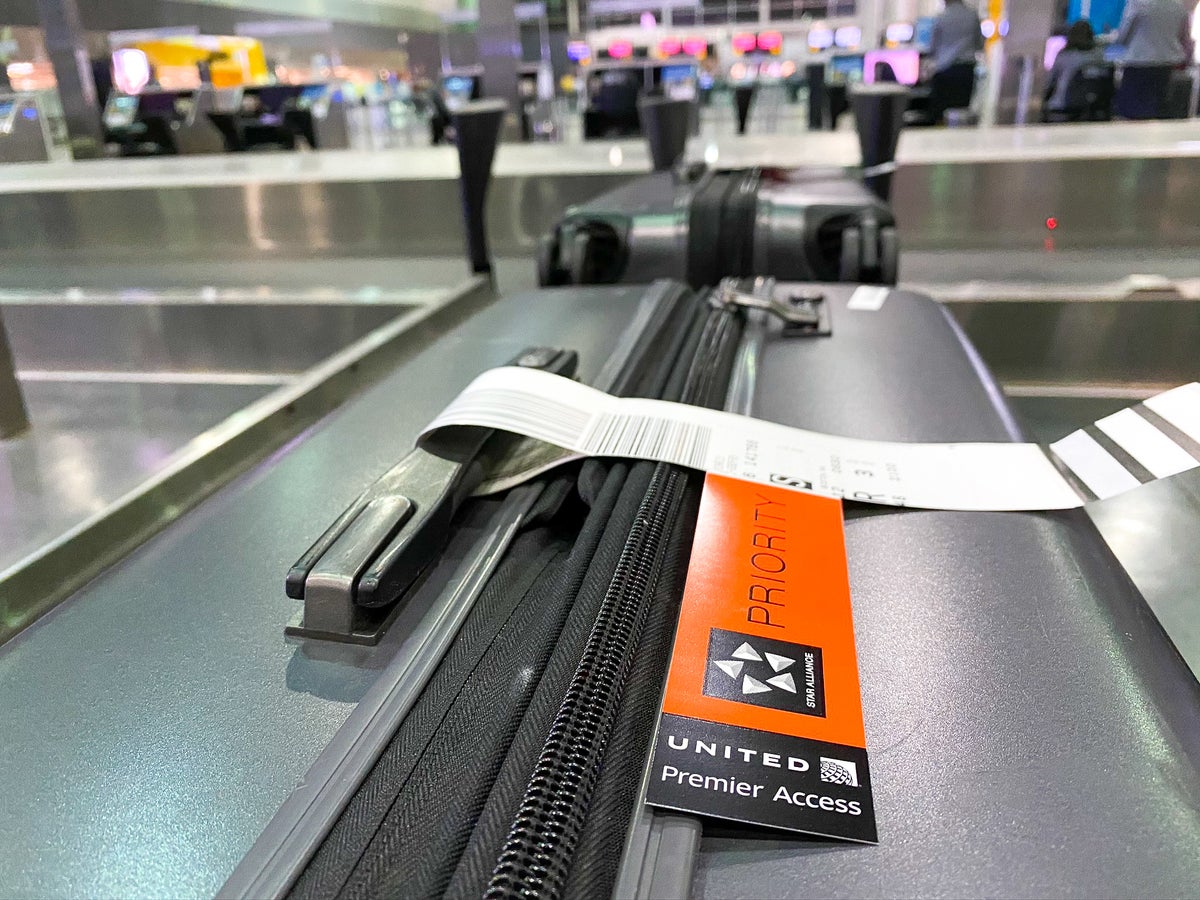
UP's Bonus Valuation
This bonus value is an estimated valuation calculated by UP after analyzing redemption options, transfer partners, award availability and how much UP would pay to buy these points.
Airline carry-on luggage size: Everything you need to know

One of the most stressful parts of flying can be the packing process, especially if you're trying to fit your items into one or two carry-on bags.
Regardless of whether you are flying a U.S. carrier or internationally, your flying with both a full-sized carry-on and personal item depends on the policy of the specific carrier. We've outlined many of those policies in this guide. Additionally, all airlines have size requirements, and some have weight restrictions.
Read on for all you need to know about traveling with carry-on bags.
What size is carry-on luggage?
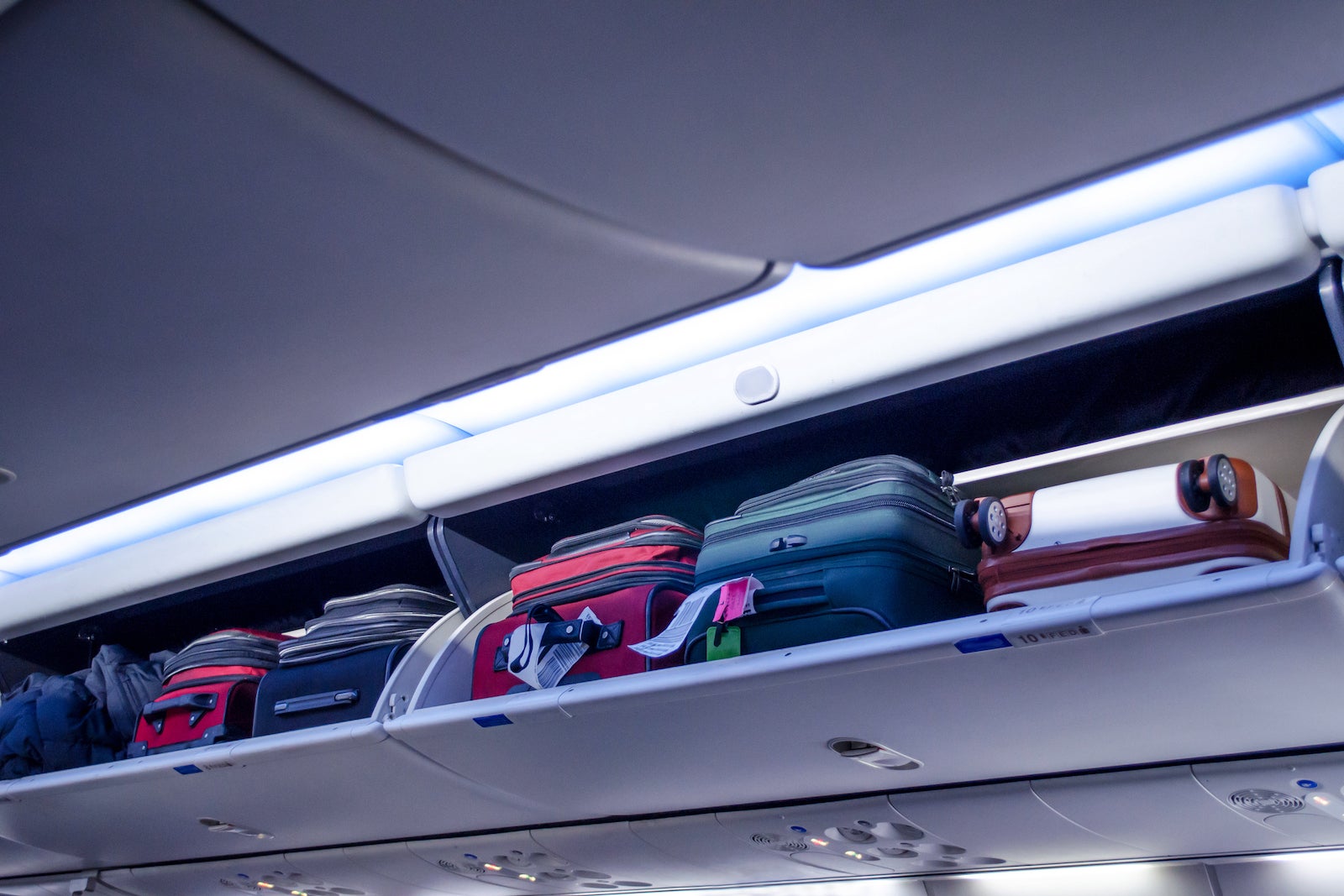
As you've likely observed, most domestic airlines allow passengers one personal item that fits underneath the seat in front of them and one larger carry-on suitable for the overhead bin.
Some airlines specify size requirements for both items, while others only restrict the overhead baggage. Just remember that a carrier's policy for the larger carry-on accounts for the size of your entire bag, including your luggage's handles and wheels.
The standard size requirements across the board for most domestic airlines for your larger carry-on is around 22 by 14 by 9 inches, so that's a good rule of thumb to keep in mind.
Here are the carry-on policies broken down by U.S. airlines:
Carry-on items stored overhead must be 24 by 16 by 10 inches. Personal items for under the seat – including purses, briefcases, cameras, food containers, laptops and backpacks — cannot be larger than 16 1/4 by 13 1/2 by 8 inches.
The combined length, width and height of carry-on baggage should be less than 45 inches. Individual items must be less than 22 by 14 by 9 inches.
American Airlines passengers should heed the 18 by 14 by 8-inch limit for personal items and 22 by 14 by 9 inches (including handles and wheels) for overhead items, which also must fit in the sizer at the gate.
All under-seat personal items on United must measure within 9 by 10 by 17 inches, while larger items cannot exceed 22 by 14 by 9 inches, including handles and wheels.
Similar to the other domestic carriers on this list, JetBlue says that personal items must measure less than 17 by 13 by 8 inches, handles and wheels included, while overhead items shall be smaller than 22 by 14 by 9 inches.
Alaska Airlines
Alaska Airlines recently changed their carry-on bag size limit for overhead items to be within 22 by 14 by 9 inches, including the wheels and handles.
Hawaiian Airlines
Carry-on items aboard Hawaiian Airlines flights cannot exceed 22 by 14 by 9 inches.
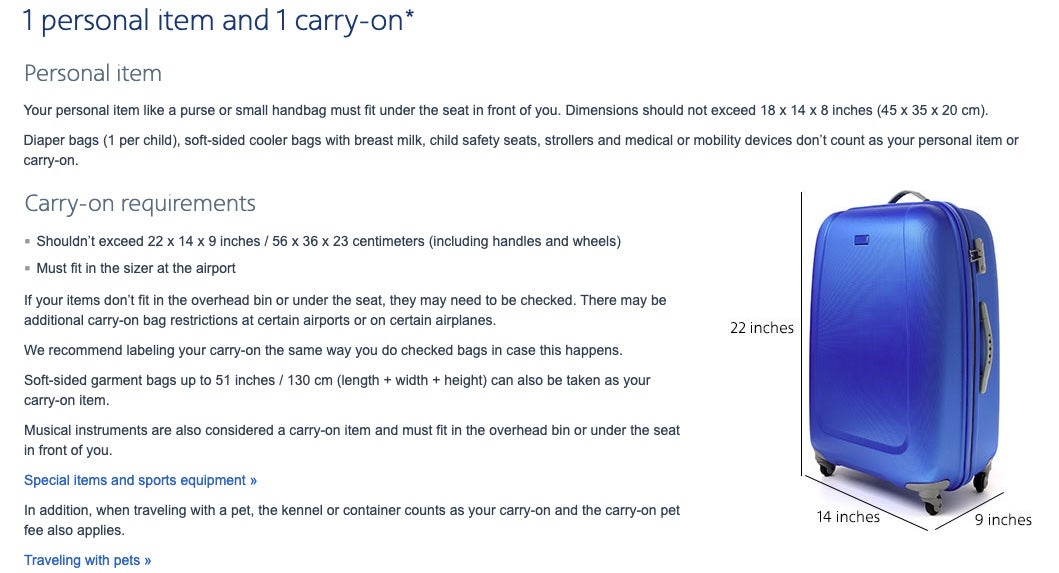
The standard carry-on size for international carriers is slightly smaller than that of the U.S., measuring overall at 21.7 by 15.7 by 9 inches, including handles and wheels.
Here are the carry-on policies for economy passengers on major international carriers:
- Air Canada: 21.5 by 15 by 9 inches.
- British Airways: 22 by 18 by 10 inches.
- Emirates: 21 by 14 by 7 inches.
- Singapore Airlines: The sum of length, width and height of each piece should measure less than 45 inches.
- Cathay Pacific: 22 by 14 by 9 inches.
- Air New Zealand: The sum of length, width and height of each piece must measure less than 46.5 inches.
- Turkish Airlines: 21 by 15 by 9 inches.
- Virgin Atlantic: 22 by 14 by 9 inches.
- ANA: 22 by 16 by 9 inches.
- Korean Air: The total dimensions of the bag must be less than 45 inches (20 by 21 by 15 inches).
- Japan Airlines: 22 by 16 by 10 inches.
- La Compagnie: 21 ⅔ by 13 ¾ by 9 ⅚ inches.
Read more: Your essential guide to duty-free shopping at the airport
Is a carry-on considered a personal item?
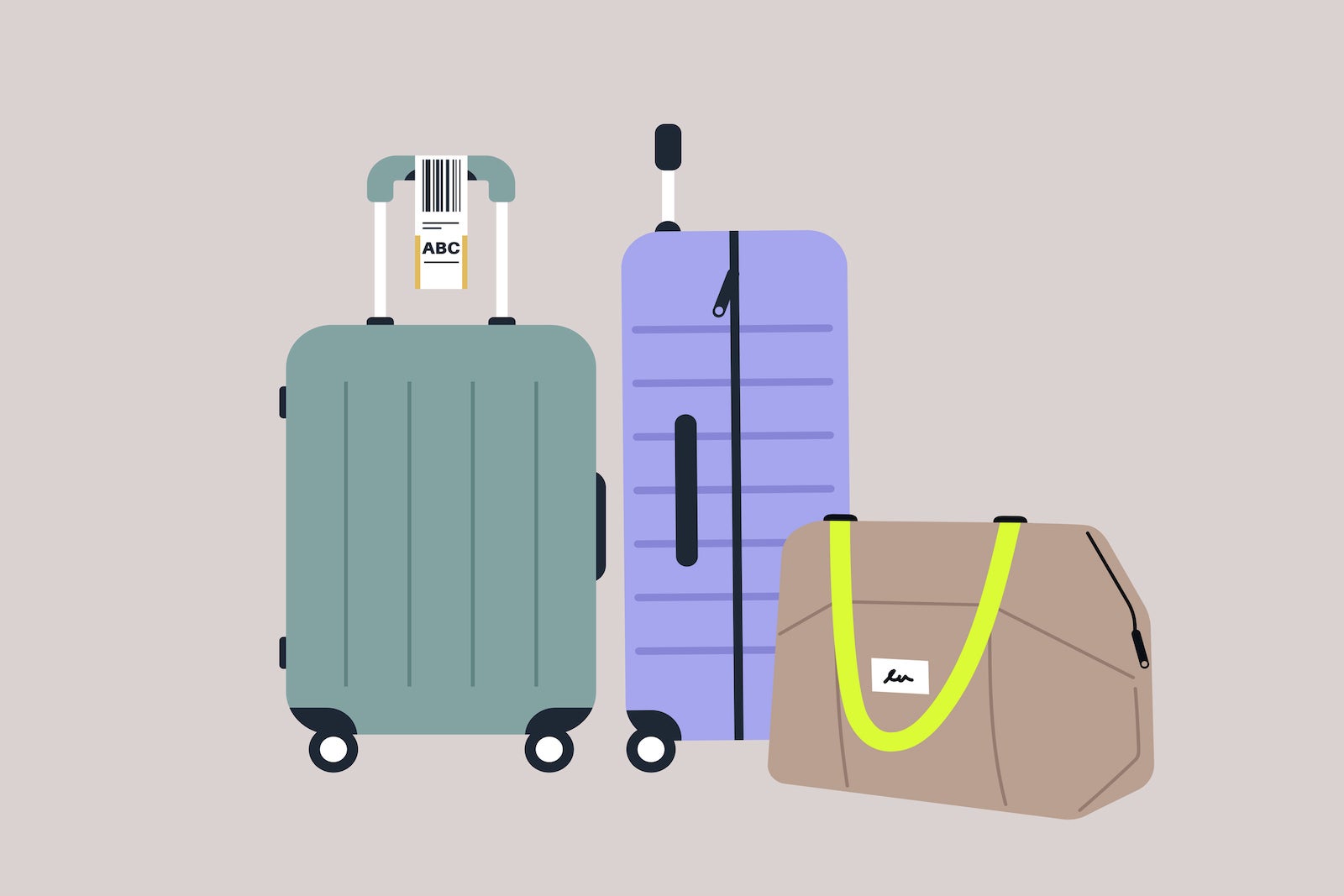
As mentioned, all airlines differentiate between smaller personal items and larger carry-on items. If your carry-on bag fits under the seat in front of you, it's considered a personal item, which includes small backpacks, purses, briefcases and laptop bags.
Larger bags, including suitcases that fit in the overhead bin compartment, are labeled as larger carry-on items.
Most domestic airlines allow passengers two carry-on items, depending on their fare type. For example, Southwest stands out among carriers for allowing passengers two free carry-on bags and two checked bags, regardless of fare type. That's also the case for Delta, American, Alaska and Hawaiian passengers.
The cheapest fare types on both United (basic economy) and JetBlue (Blue Basic) restrict fliers to one personal item that can fit under the seat in front of you.
Among international carriers, your fare type also determines whether you are eligible to bring one or two carry-on items, so be sure to pay attention to baggage allotments when booking.
For carry-on guidelines for specific airlines, see our guide for the current carry-on baggage policies for 10 major U.S. and international carriers .
Carry-on luggage weight limits
Though airlines care about size, most domestic airlines do not have weight restrictions for carry-on bags, but some enforce weight limits for specific routes. For example, Delta restricts passengers flying to and from Beijing and Shanghai to a 22-pound carry-on, while bags are limited to 15 pounds to and from Singapore.
Low-cost airlines Frontier and Sun Country both have 35-pound limits, while Hawaiian Airlines limits their carry-on bags to 25 pounds.
Otherwise, you won't likely find a blanket weight policy for carry-on bags for domestic carriers.
Just make sure your bag does not weigh too much that it becomes oversized.
On the other hand, the majority of international carriers specify weight requirements for carry-on bags dependent on the fare type. For economy fares, carry-on weight limits vary among major carriers, including:
- Emirates, Singapore Airlines, Cathay Pacific, Qatar Airways, Air New Zealand: 15 pounds.
- Turkish Airlines: 17 pounds.
- Virgin Atlantic, ANA, Korean Air, Japan Airlines: 22 pounds.
- La Compagnie: 39 pounds.
- British Airways: 51 pounds.
What is allowed in a carry-on bag?
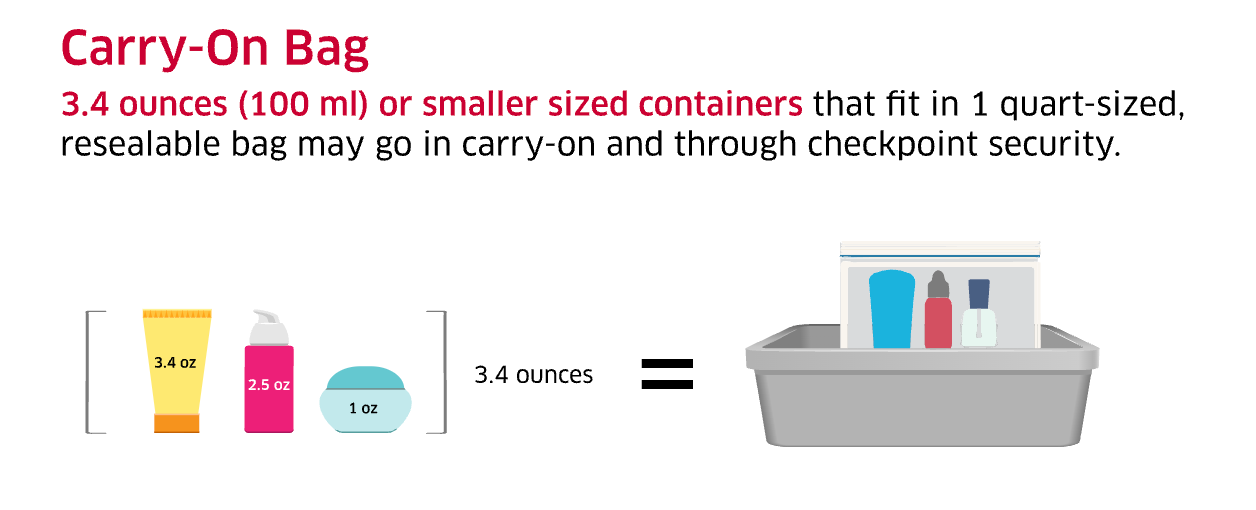
The U.S. Transportation and Security Administration (TSA) monitors carry-on bags just as they do with checked luggage, prohibiting certain items, including firearms, lithium batteries and other potentially hazardous items outlined here .
Within those confines, you're further restricted to liquids less than 3.4 ounces per their 3-1-1 rule, limiting items like toothpaste, shampoo, conditioner, mouthwash and lotion to 3.4 fluid ounces within a quart-sized bag. TSA recommends you pack full-sized liquids in your checked luggage.
In addition to liquids, your carry-on is the safest place for your most valuable items, such as your purse, electronics, passport, jewelry and medicines.
For inbound international flights to the U.S., you can carry on liquids exceeding 3.4 ounces if purchased duty-free and remain in their secure, tamper-evident bags. You'll also want to hold on to your original receipt to show the purchase was made within the preceding 48 hours, which TSA may request for screening.
Other international border agencies have similar rules prohibiting bringing certain items on airplanes, so be sure to check with your individual airline regarding those rules.
Bottom line
Depending on your fare type, most domestic airlines generally permit travelers to carry on two items — one that fits underneath the seat in front of you, generally labeled as a personal item, and a second item that fits overhead. However, you must meet certain dimension thresholds, which vary by airline.
Personal items include small backpacks, purses, briefcases and laptop bags, while larger bags, including suitcases that lie fit in the overhead bin compartment, are labeled as larger carry-on items.
Carry-on policies greatly vary by international carriers, depending on the fare type, which also determines weight requirements for carry-on bags. However, U.S. airlines generally do not have weight restrictions for carry-on items.
Related: Here's what to pack in a carry-on bag every time you travel

Luggage Sizes Chart: Ultimate Guide to Suitcase Dimensions and Travel Needs
Josephine seale.
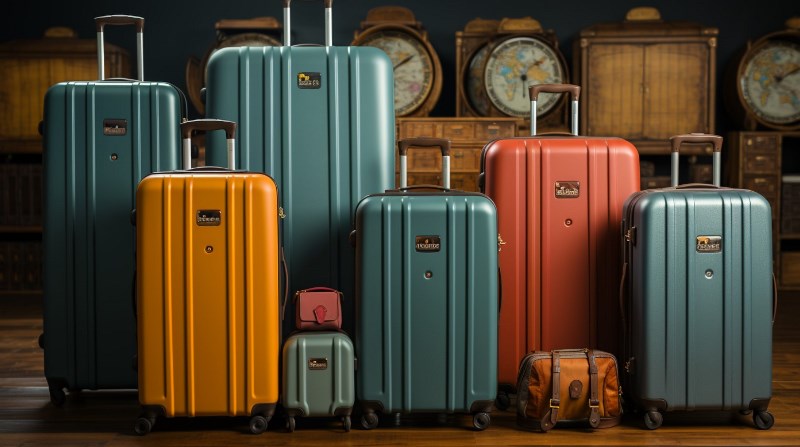
Traveling requires thorough planning, especially when it comes to your luggage. Here’s a guide to understanding the common luggage sizes to help you pack efficiently.
Table of Contents
Luggage Sizes Chart

Why Do Luggage Size Limits Matter?
Consequences of exceeding luggage size limits.
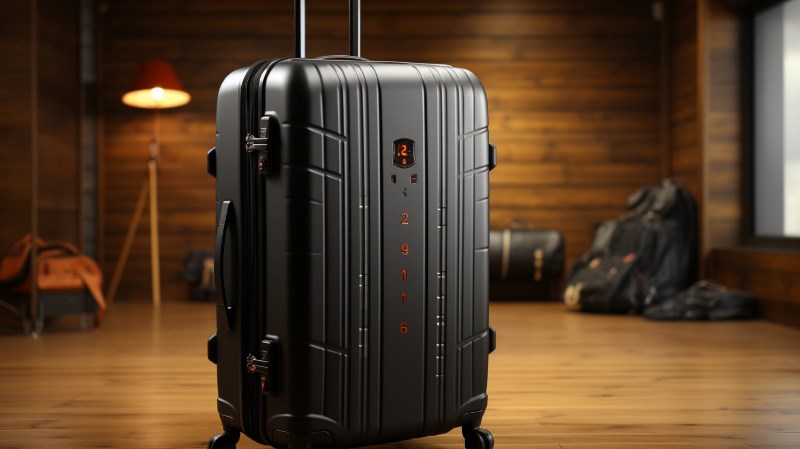
Wheels and Handles in Luggage Measurements
Exceptions to common luggage size limits, carry-on luggage size standards, prohibited items in carry-on luggage.

Checked Luggage Size Essentials
Oversized checked luggage fees, how to measure the luggage, oversized luggage consequences.

Packing Techniques
Deciphering luggage sizes: a comprehensive guide.
- Consumer Reports – Luggage Buying Guide ( https://www.consumerreports.org ): This guide is an all-encompassing resource for those looking to understand the world of luggage. From the diverse types of luggage available to nuanced features that can enhance your travel experience, Consumer Reports breaks it down seamlessly. Their emphasis on quality, durability, and value gives a well-rounded perspective. If you’re a first-time buyer or even someone seeking an upgrade, this guide is an excellent starting point.
- American Airlines – Carry-On Baggage Rules ( https://www.aa.com ): This official resource from American Airlines provides concise information on their carry-on baggage regulations. It’s straightforward, user-friendly, and offers clarity on what you can expect when flying with them. While it is specific to American Airlines, it provides a benchmark of what major airlines might expect.
- American Society of Travel Advisors ( https://www.asta.org ): ASTA offers an array of insights, not just on luggage, but on the entire travel spectrum. It serves as a hub for travel advisors, offering insights, news, and guidelines. While it may seem like a deep dive for someone merely looking for luggage guidelines, it offers an enriched perspective for frequent travelers or those looking to understand the travel industry more deeply.
About Post Author
Josephine Seale is the perfect tour guide!
She loves interacting with people of all ages and enjoys escorting individuals or groups on sightseeing tours. Josephine has a professional manner and appearance, and she always maintains a positive attitude.
Her good organizational, critical thinking, and time management skills make her an ideal candidate for this position. In addition, she is able to read, write, and communicate effectively in Spanish.
See author's posts
Affiliate Disclaimer
As an affiliate, we may earn a commission from qualifying purchases. We get commissions for purchases made through links on this website from Amazon and other third parties.
Leave a Reply Cancel reply
Your email address will not be published. Required fields are marked *
Save my name, email, and website in this browser for the next time I comment.
AIRLINE CHECKED BAGGAGE SIZE CHART
Use our airline checked baggage size chart to ensure your check in luggage dimensions are within the size limits policy of your airline's allowance rules & restrictions for domestic and international travel.
Scroll to your desired airline below or use our baggage size checking tool here .
Most airlines will allow you to check one bag and have one carry-on bag. There is normally a maximum weight limit of 50 pounds per checked bag as well as a size restriction. The most common maximum size bag allowed is 62 linear (total) inches. A common size bag for checking through is: 27" x 21" x 14".
Frequently Asked Baggage Questions
For no extra charge, a checked bag / luggage / suitcase can have a maximum combined dimensions of 62”. For those that want to know the biggest or largest size, that would be 125.98 in combined inches with Azul Airlines. Of course, excess baggage size fees will apply. Most maximum or biggest size of any luggage is around 80 inches.
The average size of checked luggage will usually be within a total linear dimensions of 62 inches, or 158cm. For example, a popular Samsonite luggage has the dimensions: 9.8” x 12.5” x 28” combined inches [60.3 inches].
2018 Airline Checked Baggage Size Chart & Guide
Before your trip, make sure you know what you can bring onboard the plane as a carry-on item and/or as checked baggage. Learn about size and weight restrictions for your aircraft and flight plan.
Our checked baggage size chart has all the popular airlines and their checked baggage size allowances. Also, you’ll find links to carry-on badges, personal item baggage size information, special items, traveling with pets, and other useful luggage information.
Airline Luggage Restrictions
Most airlines allow: 1 carry-on baggage, 1 personal item (backpack, purse, laptop bag), and 1 to 2 checked bags. There is usually a max weight and size restriction. The most common maximum size bag allowed is 62 linear (total) inches. A common size bag for checking through is: 27" x 21" x 14”.
TSA Luggage Regulations & Flight Baggage Rules
TSA carry on rules focus mostly on items that can be taken onboard a flight. Contrary to information online, TSA carry on size is more a function of what the respective airline allows. Find out the guidelines on liquids and food on our website with an official chart of restrictions.
Airline Checked-in Baggage Size Restrictions / Suitcase Sizes For International Travel
Checked baggage policy restrictions vary by airline. Most airline companies will calculate the size limits of your luggage by adding total dimensions (l x w x h) to figure out whether they will accept the luggage and if extra fees will need to be assessed. 62 in / 158 cm. Weight: 50 lbs / 23 kgs.
Max dimensions (length + width + height) of a standard checked baggage is 62 inches (158 cm). This usually includes handles and wheels. Most airlines, on international flights, allow one or two checked bags of 62 linear (total) inches to be checked in for no additional charge. For more luggage, larger size allowances, or heavier weight, you’ll have to pay an oversize, overweight or excess baggage fee.
When it comes to the largest size for check in, the 62 inches luggage dimensions is the bottom end of the size range. Many airlines allow anywhere from 80 to over 120 total linear inches of combined length, width, and height.
American Airlines Checked Baggage Policy
Weight and size limits.
- Dimension: 62 in / 158 cm
- Weight: 50 lbs / 23 kgs (First / Business Class, weight is 70 lbs / 32 kgs)
Oversize Baggage Policy
- Oversize baggage fees apply to baggage larger than 62 in / 158 cm
- AA doesn't accept checked bags over 126 in / 320 cm.
- Oversize Fees are non-refundable, per person, each way
Oversize Baggage Fees
- Between U.S., Puerto Rico, U.S. Virgin Islands and Canada - $200
- Mexico / Caribbean / Central and South America* - $200
- Brazil* - $150
- Europe (transatlantic) - $150
- China, Japan, South Korea, Hong Kong and Australia (transpacific) - $200
Delta Airlines Checked Baggage Policy
Checked baggage requirements.
- Must not exceed 62 inches (157 cm) [total length + width + height]
- Exception: Active military on military orders, bags must not exceed 80 inches [total length + width + height]
Oversized Baggage Fees
- The fees (each way) below will apply for bags measuring between 63-80 inches (161-203 cm) in combined length, width, and height
- Bags larger than 80 inches (203 cm) in combined length, width, and height are not allowed
- Exceptions may apply for specialty items [View the full list of special items here ]
United Airlines Checked Baggage Policy
- Dimension: 62 in / 158 cm (all ticket classes)
- Weight: 50 lbs / 23 kgs (United economy / Premier Silver); 70 lbs / 32 kgs (Business, First, Polaris First, Polaris Business, Premier Gold / Platinum / 1K, Star Alliance Gold)
- Exception: Active military (and their dependents) on official business - Dimensions: 115 in. (292 cm) / Weight: 100 lbs. (45 kg)
- Assistive devices are accepted at no charge
Overweight & Oversize Baggage
- United doesn't accept checked bags with total dimensions over 115 in (292 cm)
- Baggage weighing more than 100 lbs. (45 kg) will not be accepted (exceptions: assistive devices and musical instruments)
- Cities do not allow excess baggage or oversized baggage at any time: Havana, Cuba (HAV) and Tegucigalpa, Honduras (TGU)
Baggage Fees
- Additional charges apply to oversized / overweight / extra baggage
- Use the United Airlines Baggage Calculator to figure out accurate baggage fees: https://www.united.com/CMS/en-US/travel/Pages/CheckedBaggage.aspx#calc
Southwest Airlines Checked Baggage Policy
- Dimension: 62 in / 158 cm [Max. 80in]
- Weight: 50 lbs [Max. 100lbs]
- Exception: Military traveling on active duty or permanent chage of staion orders - Dimensions: 80 in. / Weight: 100 lbs. (45 kg)
- Southwest doesn't accept checked bags with total dimensions over 80 in
- Overweight / oversized baggage: $75 USD (if both, only one $75 USD charge will apply)
- Excess baggage: $75 USD (in addition to any applicable overweight / oversized fees)
Other Types of Baggage
- Assistive Devices - Wheelchairs, medical oxygen, etc...
- Special Baggage - Pets, batteries, musical instruments, etc...
- Travel recommendations
- The taste of travel
- Tips & tricks
- Travel experiences
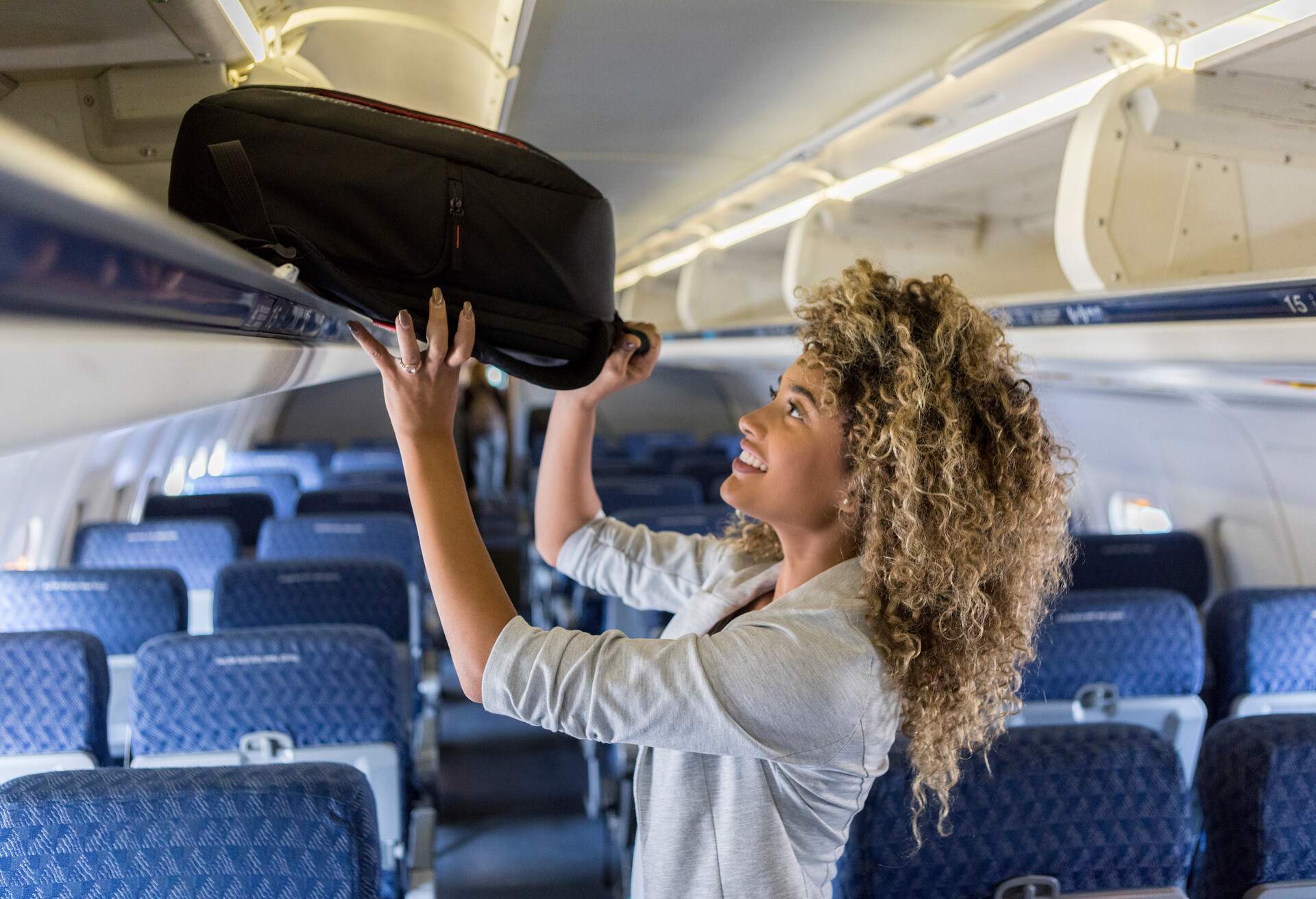
Travel right: Carry-on luggage size and weight guide

Unclear if your carry-on bag is allowed on? This article has everything you need to know to avoid last-minute encounters with TSA, excess baggage fees and a stressful start to your vacation. Use this airline-by-airline guide to see what size and how heavy your carry-on luggage can be .
In this post
- What size is carry-on luggage?
- What is the carry-on luggage weight limit?
- What is a personal item on a plane?
- What is the standard international carry-on luggage size?
- Carry-on luggage vs. a personal item: what’s the difference?
- Carry-on luggage policies for domestic airlines
- Carry-on luggage policies for international airlines
And with KAYAK’s Baggage Fee Assistant , you can see whether your luggage is included in the overall flight price. Just search for your flights on KAYAK, add the bags you want to take using the tool on the left and watch your results instantly update.
1. What size is carry-on luggage?
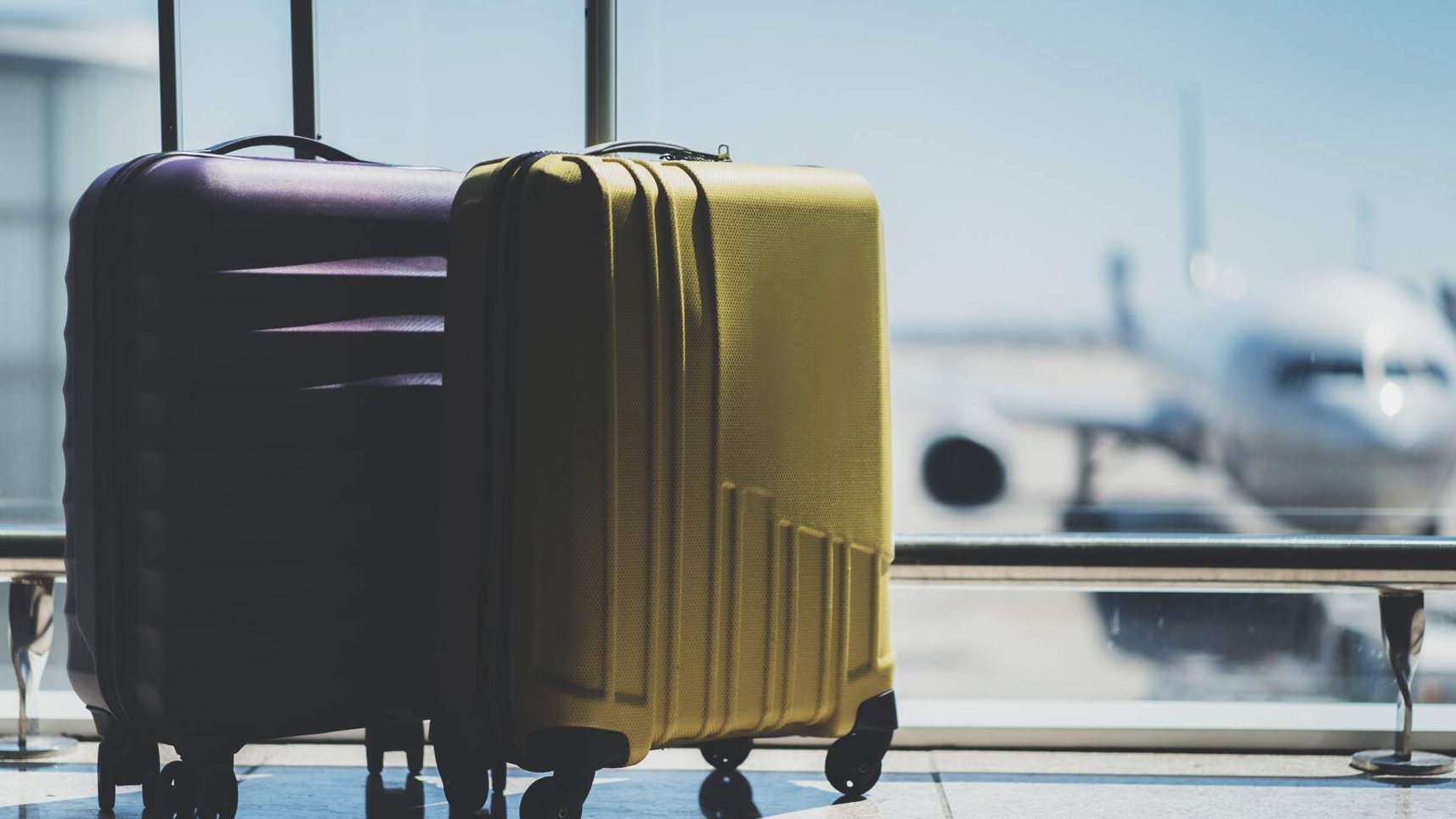
Most airlines follow very similar size regulations when it comes to carry-on luggage. The majority go by a standard height, width and depth measurement.
In general, standard domestic carry-on luggage size is 22 x 14 x 9 inches. If you’re flying internationally, that may vary a little to 21.5 x 15.5 x 9 inches. Remember, those dimensions include the handle, wheels and anything else that may protrude from your suitcase so don’t miss them from your measurements.
A few airlines, including Delta, American Airlines, Air Canada and Southwest Airlines, measure their carry-on using what’s called “linear inches”. This is a measurement that adds up the height, width and depth of your carry-on to create a single total number.
For example, Delta’s carry-on limit is 45 linear inches – so if the combined height, width and depth of your luggage is less than 45 inches, you can take it as carry-on:
✅ 22 (h) + 14 (w) + 9 (d) = 45 inches ✅ 25 (h) + 10 (W) + 10 (d) = 45 inches ❌ 24 (h) + 14 (w) + 8 (d) = 46 inches
Carry-on size limits are there to make sure everyone’s luggage will fit in the overhead bins. I always try to fly with only carry-on luggage no matter where I go or for how long. Apart from it forcing me to not overpack, I always travel easier knowing my luggage is in reach rather than in the hold, or even worse, still back at the airport!
2. What is the carry-on luggage weight limit?
Weight limits for carry-on luggage are even more of a minefield than size restrictions, although generally they’re not as strictly enforced. That doesn’t mean, however, that you can fill your case to bursting and make it so heavy it requires a group effort to get it in the overhead bin.
Many major airlines such as American Airlines, Delta, JetBlue and United Airlines have no weight limits at all. As long as you can lift your bag over your shoulders, high enough to get it in the overhead storage bin, you’re fine.
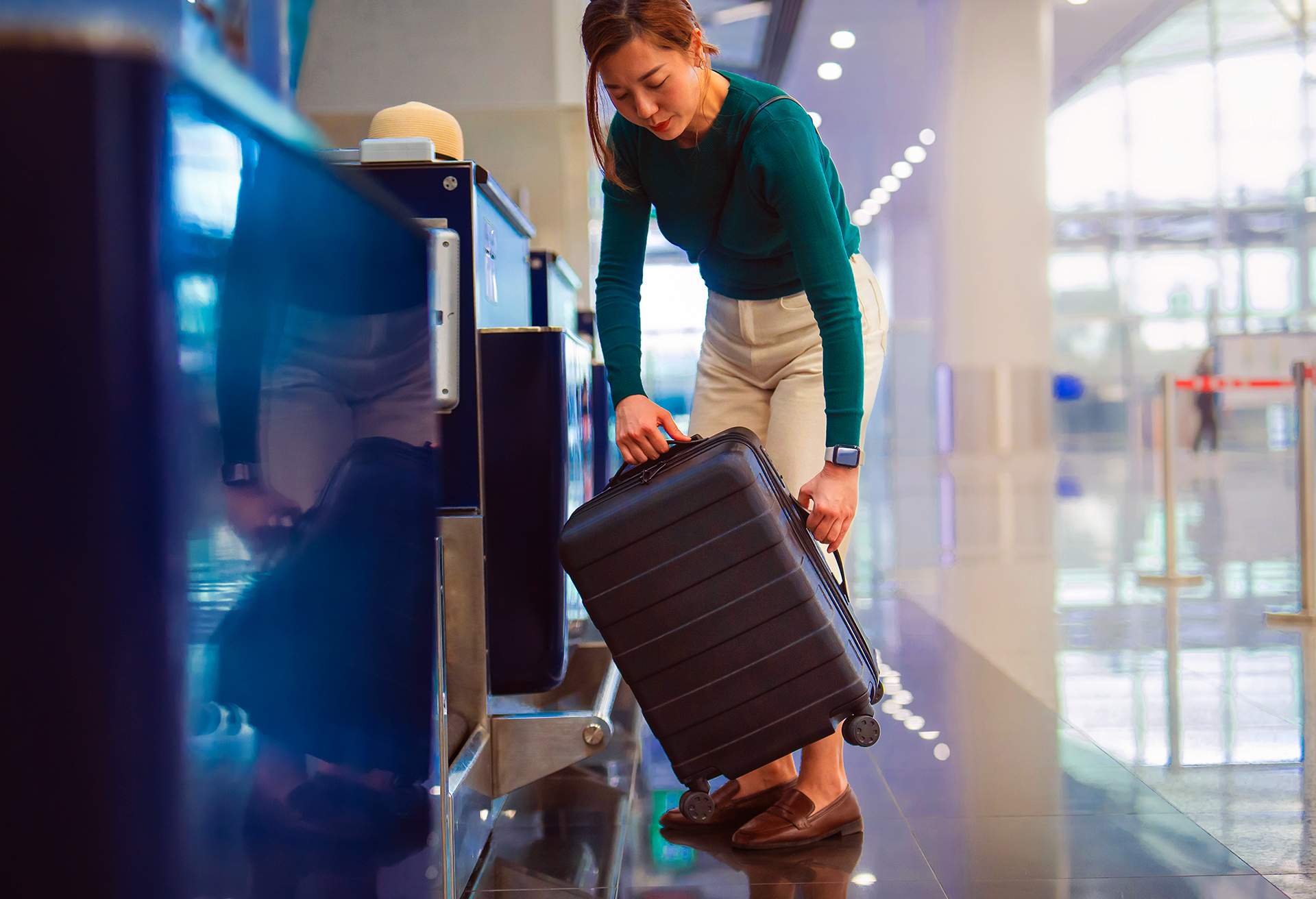
Other limits vary dramatically by airline, and can even change for the same airline depending on where you’re flying from and to. From a lightweight 15 lbs with Qantas, Qatar and Singapore Airlines to a more manageable 51 lbs with British Airways, it’s always important to check in advance.
As long as you’re sensible and within a few pounds though, you shouldn’t have any problems.
3. What is a personal item on a plane?
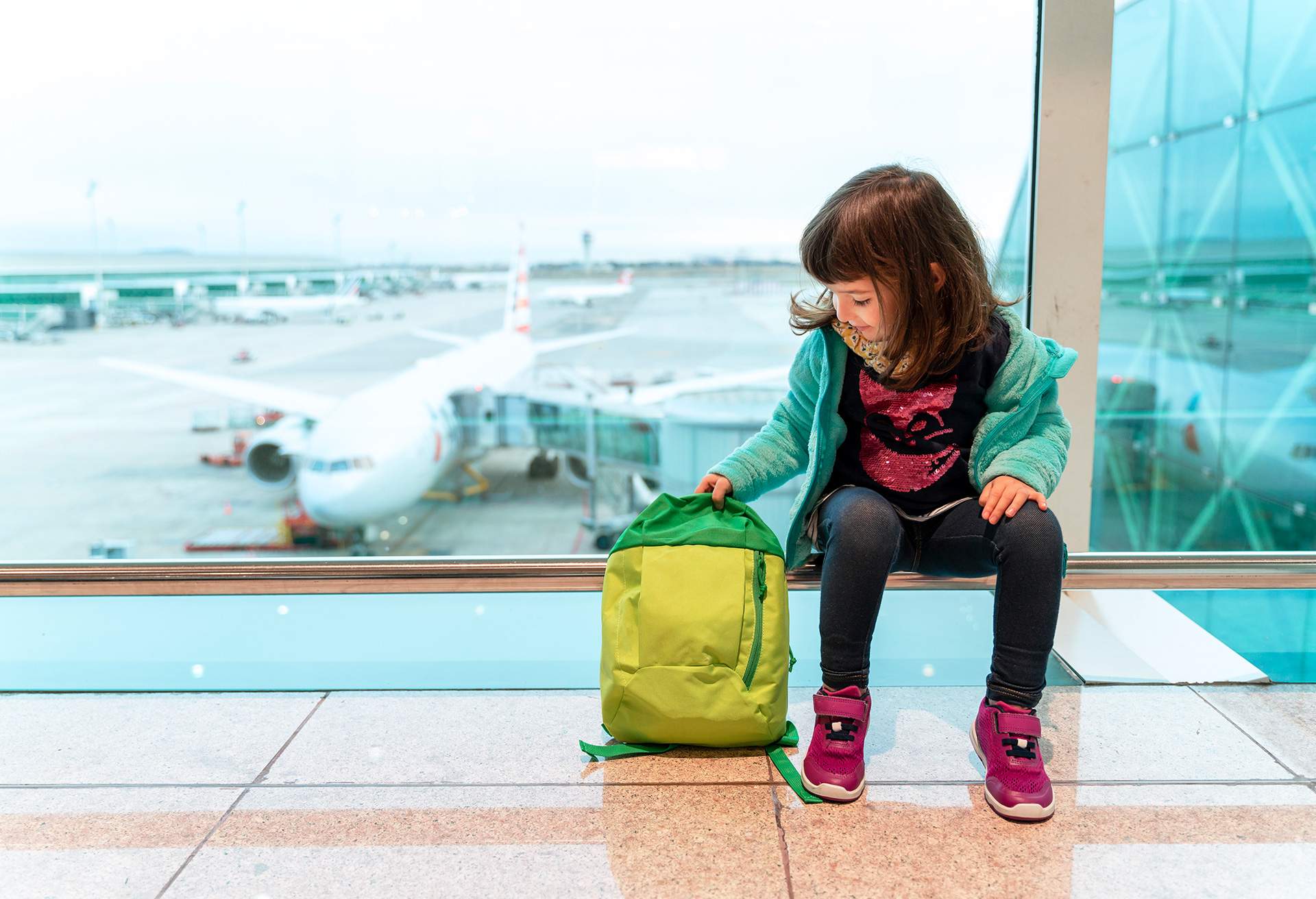
You may see some airlines include carry-on luggage and “one personal item” in their size guidelines. That personal item refers to a small bag – typically a laptop bag, purse or briefcase . Airline size regulations for personal items vary wildly, but as long as it’s small enough to fit easily under the seat in front of you, there shouldn’t be any problems.
If you have something specific to carry such as a baby bag for diapers and food, a pair of crutches or something particularly fragile, airlines tend to be quite accommodating in including it as carry-on. To be on the safe side, you should always check directly with the airline in advance.
4. What is the standard international carry-on luggage size?
Carry-on luggage sizes can vary between domestic and international flights, although not by much. For most international flights, the maximum carry-on luggage size is 21.5 x 15.5 x 9 inches or 46 linear inches . If your luggage fits within these dimensions, you’ll have no problems treating it as carry-on.
There are some exceptions such as Qatar Airways, which states measurements of 20 x 15 x 10 inches or 45 linear inches for its carry-on baggage. Pay attention in particular if you’re flying in Europe or with smaller regional airlines, as they can have very different restrictions depending on the airplane.
5. Carry-on luggage vs. a personal item: what’s the difference?
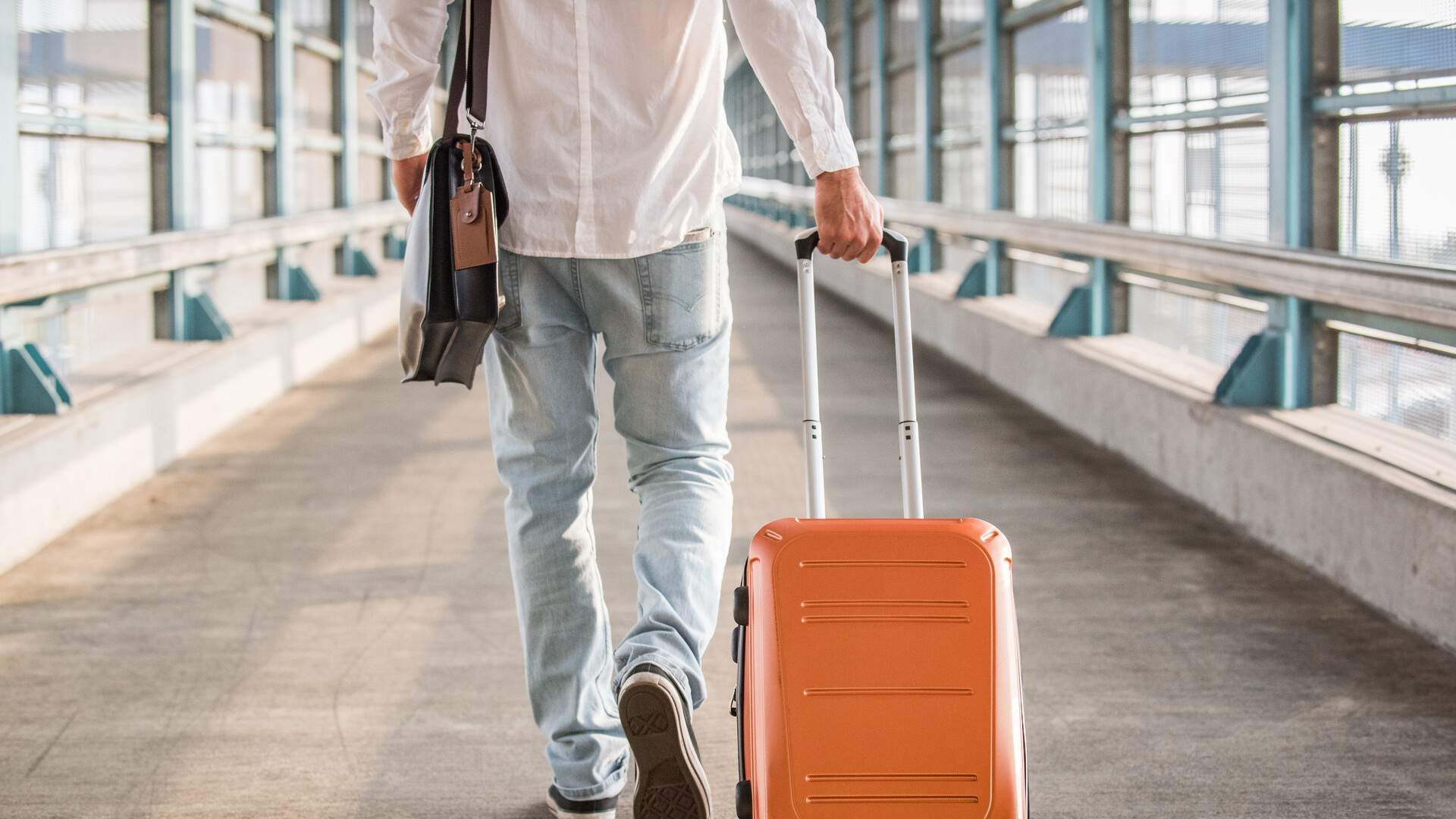
The practical difference between carry-on luggage and a personal item is that the former is for storage in the overhead bin and the latter for under the seat in front of you.
Your carry-on luggage is the bag you don’t hand over at check-in. If you’re traveling light, using your carry-on luggage allowance can prevent you having to check any bags at all. That’s always a win, as your bags will never get lost or left behind and you don’t have to wait at baggage collection once you’ve landed.
Many airlines include a carry-on luggage allowance in their ticket price. Some – especially small and budget airlines – charge extra for it, although it’s usually still cheaper than paying for checked luggage .
Personal items are things like your purse or laptop, briefcase or camera, and are usually permitted on top of your carry-on luggage free of charge. Size allowances vary by airline but most simply follow the ‘fit under the seat in front of you’ guideline.
If you’re not sure what you can take in your carry-on or personal item, check out our FAQs .
Not sure if your carry-on luggage size fits your airline policy?
To take the anxiety out of boarding and make sure your carry-on is always compliant, we created a fun Bag Measurement tool . Download the KAYAK app and you’ll never need a tape measure again.
Just open the app and tap on “Measure your bag.” Using your camera, capture your luggage and our app will do the math for you to give your bag’s exact measurements. Handily, it also compares airline baggage policies in one place too, so you can quickly check your carry-on fits no matter who you’re flying with. Watch the video below to see how it works.
6. Carry-on luggage policies for domestic airlines
Although there are differences in carry-on luggage size and weight restrictions between lots of different airlines, many also now tow a similar line to each other.
When it comes to carry-on baggage, few domestic airlines now specify a weight limit. Of those we’ve detailed below, only Hawaiian Airlines and Frontier Airlines impose weight restrictions. The rest go by dimensions only.
For personal items, Delta, Alaska and Hawaiian Airlines all dispense with measurements, instead simply asking that it fits under the seat in front of you. None of the domestic airlines impose a weight limit.
To make it easier for you to search, we’ve gone through the main domestic US airlines and detailed the size and weight limits for both carry-on luggage and personal items. We’ve also included any other relevant information, tools and tips we think you might find useful when flying with each specific airline.
Alaska Airlines
American Airl ines
Hawaiian Airlines
Southwest airlines, spirit airlines, united airlines.
- Carry-on luggage size: 22 x 14 x 9 inches
- Carry-on luggage maximum weight: Not specified
- Personal item size: Must fit under the seat in front of you
- Personal item maximum weight: Not specified
The Alaska Airlines carry-on luggage allowance includes one carry-on bag and one personal item for all fares.
American Airlines
- Personal item size: 18 x 4 x 8 inches
The American Airlines carry-on luggage allowance includes one carry-on bag and one personal item for all fares, Basic Economy included.
- Carry-on luggage size: 22 x 14 x 9 inches or 45 linear inches
- Carry-on luggage maximum weight: None (with exceptions)
- Personal item size: Must fit under the seat in front of you
- Personal item maximum weight: Not specified
All Delta fares include one carry-on bag and one personal item. Most routes have no weight limit for carry-on with a few exceptions. Flying to or from Beijing or Shanghai in China comes with a 22lb weight limit, and from Singapore it’s a 15lb limit.
- Carry-on luggage size: 24 x 10 x 16 inches
- Carry-on luggage maximum weight: 35 lbs
- Personal item size: 14 x 18 x 8 inches
Frontier fares include only a personal item and no carry-on luggage. That means you’ll need to add and pay for carry-on luggage, with prices varying by route and when you add it. As always, adding it when you book your flights will be cheapest.
As always, there are exceptions. If you buy one of the WORKS or PERKS fare bundles, carry-on (as well as checked) baggage is included. And if you’re an Elite member of the FRONTIER Miles rewards program you too are blessed with carry-on included.
- Carry-on luggage size: 22 x 14 x 9 inches
- Carry-on luggage maximum weight: 25 lbs
Hawaiian Airlines includes carry-on luggage and a personal item on all fares, but watch out for that weight limit.
- Carry-on luggage maximum weight: None
- Personal item size: 17 x 13 x 8 inches
You can take a carry-on bag and personal item on all fares except a Blue Basic ticket, where you can only bring a personal item – most of the time. There are, of course, some exceptions.
If you’re in the US military, are an unaccompanied minor, or are traveling to or from the UK or Europe, including connecting flights , you can take carry-on with a Basic Blue fare . The same applies if you upgrade your seat or reach the giddy heights of Mosaic status in JetBlue’s TrueBlue rewards program.
- Carry-on luggage size: 24 x 16 x 10 inches
- Carry-on luggage maximum weight: Not specified
- Personal item size: 16.25 x 13.5 x 8 inches
Note: As well as offering comparatively generous carry-on and personal item sizes, Southwest also includes both in all its fares.
- Carry-on luggage size: 22 x 18 x 9 inches
- Personal item size: 18 x 14 x 8 inches
- Personal item maximum weight: None
Spirit keeps its flight prices low by charging for carry-on baggage and allowing only a smaller personal item for free. Fees vary depending on the route and when you buy it.
If you add when booking your flight, the average fee is $37, although that can be lower for domestic US flights. Add it later and it gets more expensive the longer you leave it, rising to $65 if you pay at the gate. The moral being, always add luggage when you book to get the best deal.
- Personal item size: 17 x 10 x 9 inches
If you’re flying domestically or between the US and Canada, you can bring one carry-on bag and one personal item on all fares except Basic Economy, where you can only bring a personal item.
If you’re flying to South America or across the Atlantic or Pacific on a Basic Economy fare, you can bring carry-on luggage and a personal item.
Certain MileagePlus, Premier and Star Alliance Gold members also qualify to bring a carry-on to all flights no matter their fare. Check the United carry-on guide for details.
7. Carry-on luggage policies for international airlines
Many of the international airlines have different fares and a confusing array of classes, from economy to first. These come with different carry-on and personal item restrictions, so be sure to check which class ticket you have before packing.
Aer Lingus, Air Canada, Lufthansa, Scandinavian Airlines (SAS) and Turkish Airlines all have the same carry-on size limit but weight allowances vary. Almost all of the International airlines we’ve listed impose carry-on weight restrictions, and many on personal items as well. The only exception is Air Canada.
British Airways
Qatar airways, scandinavian airlines (sas), turkish airlines.
- Carry-on luggage size: 21.5 x 15.5 x 9.5 inches
- Carry-on luggage maximum weight: 22 lbs
- Personal item size: 13 x 10 x 8 inches
Aer Lingus has gone to town on the complexity of its carry-on policies and prices.
If you’re flying trans-Atlantic, your carry-on and personal item are included in your fare. If you’re flying in Europe, you’ll need to book a “Carry-on bag with priority boarding” ticket and pay upwards of €9.99. Or you can check your bag into the hold, in which case it’s free.
There are a raft of exceptions to this including different fare types and connections, so you should check carefully when you book.
If you’re flying Aer Lingus Regional (that uses smaller planes limited mostly to Ireland and the UK), the allowances shrink. Your carry-on must be a maximum of 18.5 x 13 x 8 inches and weigh no more than 15 lbs.
Air Canada lets you bring a carry-on bag and personal item on all its fares, but does stress that you must be able to lift your carry-on into the overhead bin unassisted.
- Carry-on luggage size: 21.6 x 13.7 x 9.8 inches
- Carry-on luggage maximum weight: 26.4 to 40 lbs (fare dependent) including personal item
- Personal item size: 15.7 x 11.8 x 5.8 inches
- Personal item maximum weight: 26.4 to 40 lbs (fare dependent) including carry-on luggage
If you’re traveling with Air France on an Economy ticket, you can take one carry-on and a personal item with a combined weight of 26.4 lbs. If you’re flying in Premium Economy, Business, or La Première, you can take two carry-on bags and one personal item with a combined weight of 40 lbs. Air Canada lets you bring a carry-on bag and personal item on all its fares but does stress that you must be able to lift your carry-on into the overhead bin unassisted.
- Carry-on luggage size: 22 x 18 x 10 inches
- Carry-on luggage maximum weight: 51 lbs
- Personal item size: 16 x 12 x 6 inches
- Personal item maximum weight: 51 lbs
British Airways includes a carry-on bag and personal item in all its fare prices, with generous size allowances.
- Carry-on luggage size: 22 x 17.5 x 9.5 inches
- Carry-on luggage maximum weight: 33 lbs
- Personal item size: 17.5 x 14 x 8 inches
- Personal item maximum weight: 33 lbs
Another of Europe’s huge budget airlines, easyJet offers only a personal item to take free on board, which they market as a “small cabin bag.” For a proper size carry-on bag you’ll need to book a FLEXI Fare or an Up Front or Extra Legroom seat, or just add a large cabin bag separately. Prices start from £5.99.
- Carry-on luggage size: 22 x 15 x 8 inches
- Carry-on luggage maximum weight: 15 to 30 lbs (fare dependent)
- Personal item size: 22 x 15 x 8 inches
- Personal item maximum weight: 15 lbs
Economy class passengers can bring a single carry-on weighing 15 lbs. Premium Economy passengers can up that to 22 lbs. Business and First Class can bring two carry-ons of up to 15 lbs each. As with Qatar Airways, tickets issued in Brazil have a weight limit of 22 lbs.
Beware too that Emirates only allows one item for Economy and Premium Economy fares – either a carry-on or a personal item, not both. It also notes that if you carry a garment bag it must be no more than eight inches thick when folded.
- Carry-on luggage size: 21.5 x 13.5 x 9.5 inches
- Carry-on luggage maximum weight: 26 to 40 lbs (fare dependent) including personal item
- Personal item maximum weight: 26 to 40 lbs (fare dependent) including carry-on luggage
KLM’s policies change with their fares. Economy gets one carry-on and one personal item up to 26 lbs in combined weight. Premium Comfort gets two carry-ons and a personal item but the same combined weight of 26 lbs. Business Class gets the same as Premium Comfort but with a weight increase to 40 lbs.
And if you bring a baby on your lap, you can take one extra carry-on weighing up to 26 lbs.
- Carry-on luggage size: 21.5 x 15.5 x 9 inches or 22.5 x 21 x 6 inches for foldable garment bags
- Carry-on luggage maximum weight: 17.5 lbs
- Personal item size: 15.5 x 11.5 x 4 inches
All Lufthansa Economy Class and Premium Economy Class fares include one carry-on bag and personal item, with size and weight restrictions. Business and First Class fares include two carry-on bags, although the second bag may need to be checked in on flights from Italy, India and the USA.
- Carry-on luggage size: 20 x 15 x 10 inches
- Carry-on luggage maximum weight: 15 to 33 lbs (fare dependent)
- Personal item size: Not specified
Economy Class Qatar Airways passengers can take one carry-on and one personal item weighing up to 15 lbs. Business and First class can take two carry-on bags and one personal item weighing up to 33 lbs. Tickets issued in Brazil have a weight limit of 22 lbs.
It’s worth noting that Qatar Airlines considers your laptop and case part of your carry-on and not a personal item. Note too that 20 inch luggage length is shorter than most other carriers.
- Carry-on luggage size: 21.5 x 15.5 x 8 inches
- (Priority fares) Carry-on luggage maximum weight: 22 lbs
- (Priority fares) Personal item size: 15.5 x 8 x 10 inches
Budget airline Ryanair keeps its prices low by allowing only a smaller personal item as part of the fare price. You’ll need to buy its Priority & 2 Cabin Bags option if you want to take a carry-on bag weighing up to 22 lbs. Prices vary by route and when you book.
Ryanair’s Priority bundle also lets you board the plane early, but don’t be fooled! This often means standing at the front of the queue in a corridor instead of relaxing at the gate while waiting for the plane to be ready.
- Carry-on luggage size: 21.5 x 15.5 x 9 inches
All SAS fares allow you to take one carry-on bag and a personal item with the exception of the Go Light fare – but only if you’re traveling in Europe. On this fare you’ll need to pay for your carry-on bag. If you’re on a Go Light fare to or from Asia, Canada or the US, your carry-on is included.
Plus and Business Class passengers can take two carry-on bags with them. SAS also notes you can bring airport purchases and Duty Free bags onboard with you at no cost.
- Personal item size: 15.5 x 11.5 x 6 inches
- Personal item maximum weight: 9 lbs
Turkish Airlines Economy Class passengers can take one carry-on and one personal item on board. Business Class passengers can take one extra carry-on of the same weight and dimensions.
For both domestic and international flights, infant passengers are also allowed one more carry-on bag.
- Personal item size: 16 x 12 x 8 inches
All fares can take a personal item on board , but you can only take a carry-on bag if you’re on a TimeFlex Fare, are a Premium customer, require assistance at the airport or are traveling with a child younger than two.
How was this guide created?
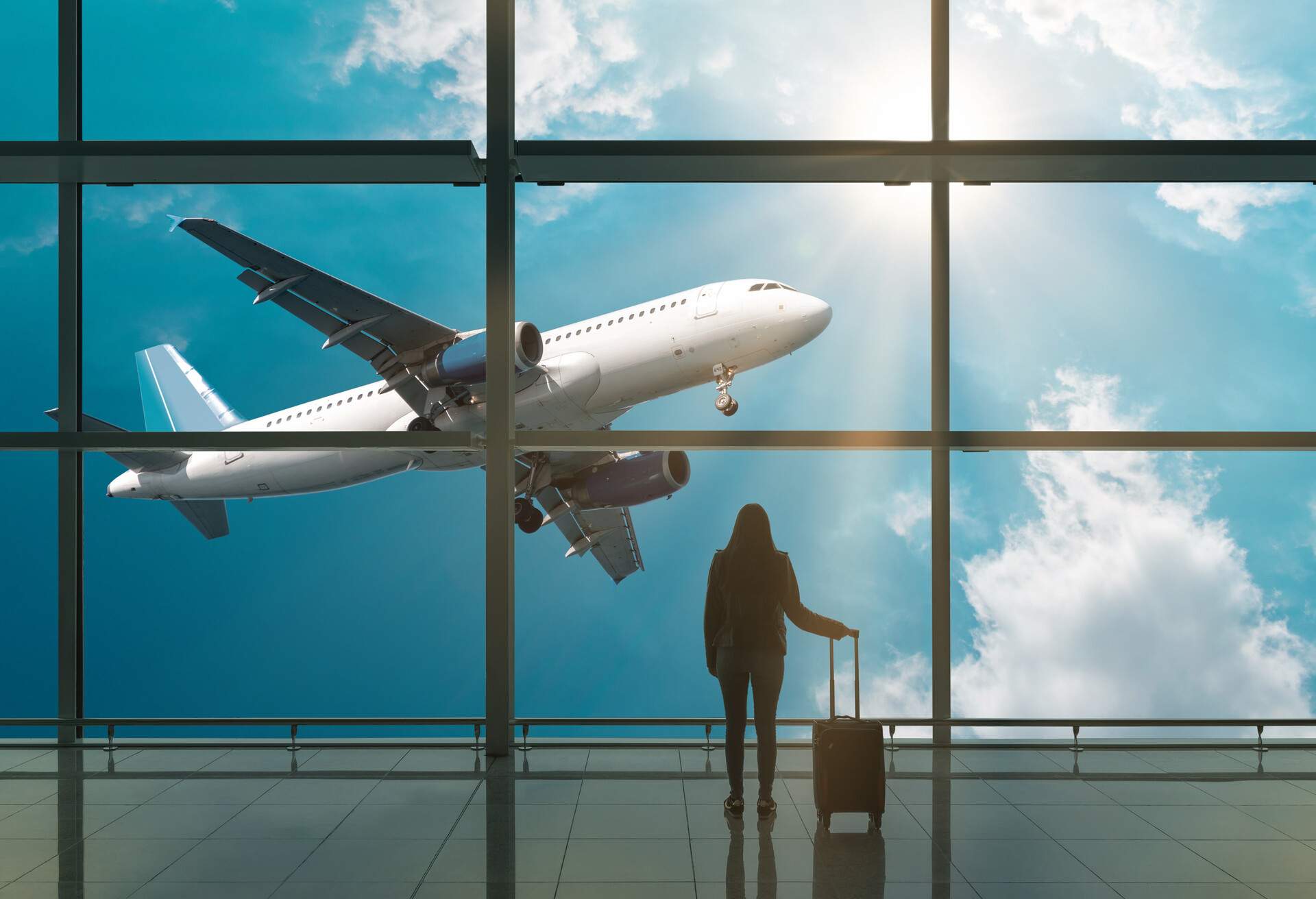
Experience and research! I’ve been traveling the world and writing stories about it for 20 years and have one mantra: carry-on is king. Unless I’m nervously checking in surfboards or skis, I only ever pack a carry-on and personal item.
Over time I’ve learned a lot about the tricks to success and pitfalls of getting carry-on wrong. This guide is a culmination of that experience combined with extensive research into US and international airline luggage policies. I also got great advice from the KAYAK teams who build the features and tools you use to book your travel.
If you found this article helpful, we’ve got plenty more inspiration and information to share. Unsure where to travel this year? Check out our guide to traveling with a carry-on vs checked bag and if you’re thinking of traveling off-season, this in-betweasons guide has an in-depth breakdown of prices and places to visit. Dive in!
This post is part of our Flight guide. Want to make sure you get the most out of your trip? Read about how to find cheap flights in our guide.
Carry-on luggage FAQs
A backpack is generally considered a personal item rather than a carry-on, as long as it fits below the seat in front of you or meets the dimensions specified by the airline.
If you’re traveling with a full size backpack that can only be stored in the overhead bins, this would qualify as carry-on luggage. As always, check the permitted dimensions and weight before you travel.
A duffel bag is typically considered carry-on luggage, yes. This does, of course, depend on its dimensions which are almost always the deciding factor for airlines over the type of luggage you have.
If it’s too big to fit under the seat in front of you and has to go in the overhead bin, you should consider it to be carry-on luggage rather than a personal item.
None of the international airlines we’ve mentioned in this guide would allow a 24-inch suitcase as carry-on, as it doesn’t meet their size requirements. Domestically, both Frontier and Southwest Airlines would allow you to take your 24-inch suitcase as carry-on thanks to their generous size limits.
Generally, I’d say a 24-inch bag will be treated as check-in luggage more often than carry-on, so think carefully before traveling with it!
The TSA has strict rules around what you can take in your carry-on luggage. Generally speaking you can take most things you’ll need for your journey.
Foods including fruits are fine. If you’re taking baby foods and medicines it’s worth checking with the airline first to make sure they don’t breach liquid limits. If you have support devices like crutches, walking stick, stroller or wheelchair, you shouldn’t have any problems but let the airline know in advance, just to be sure.
The TSA has strict rules around what you can’t take in your carry-on luggage . Rules against carrying weapons and ammunition are obvious, but it’s liquid allowances that catch most people out.
Currently, you can’t bring any liquid, gel, aerosol, cream or paste containers bigger than 3.4 ounces (100ml if you’re in Europe). If you do, it’ll be confiscated at security or you’ll be turned away if you’re not willing to relinquish it. Exceptions include medications and children’s foods but it’s always worth checking in advance to be sure.
Disclaimer: prices and information are correct as of 21.07.2023 and may vary with time.
About the author


Explore more articles
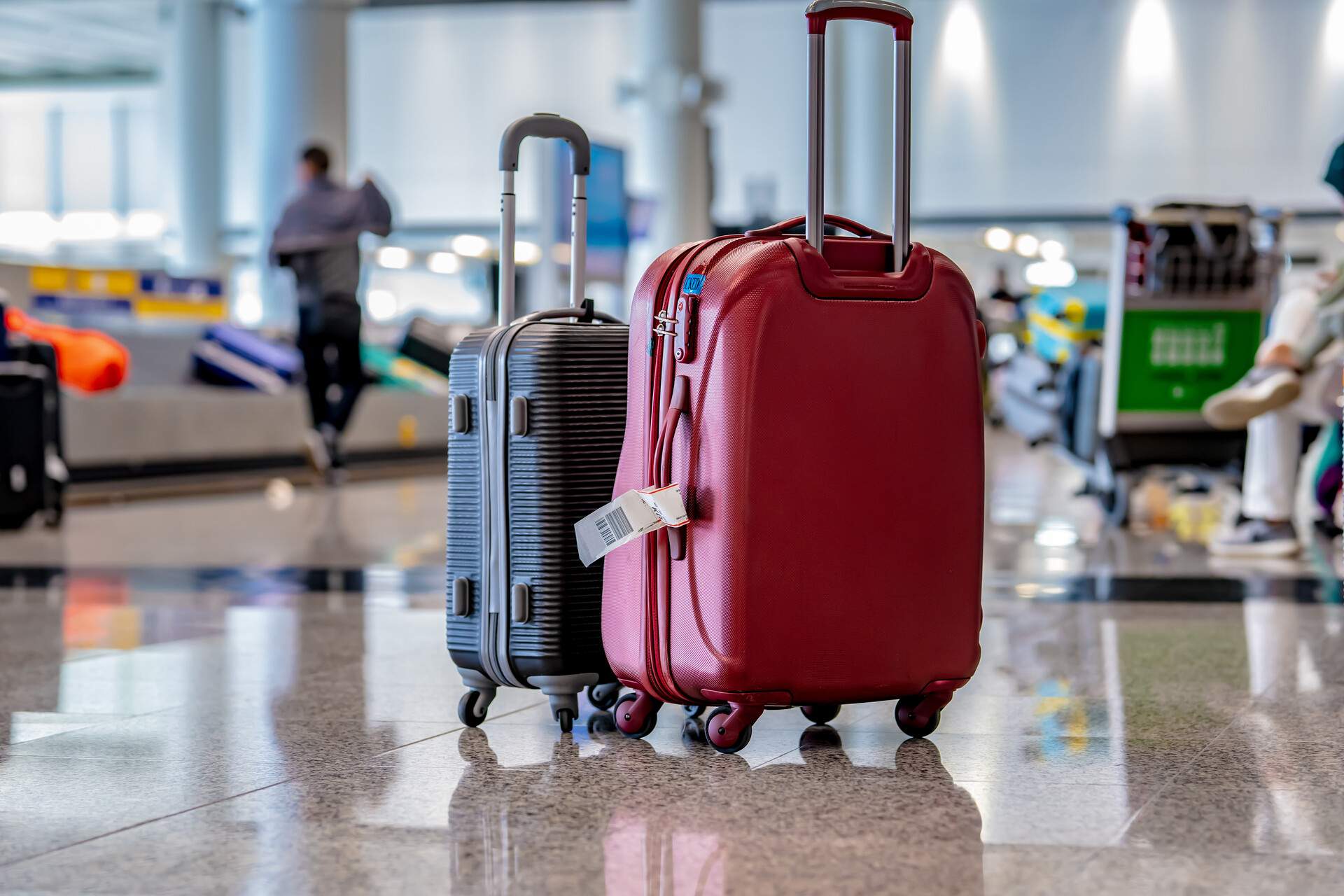
California consumers have the right to opt out of the sale * of their personal information. For more information on how we securely process personal information, please see our Privacy Policy .
Do not sell my info ON
* The definition of "sale" under the California Consumer Privacy Act is applicable only to California consumers.
- Credit cards
- View all credit cards
- Banking guide
- Loans guide
- Insurance guide
- Personal finance
- View all personal finance
- Small business
- Small business guide
- View all taxes
You’re our first priority. Every time.
We believe everyone should be able to make financial decisions with confidence. And while our site doesn’t feature every company or financial product available on the market, we’re proud that the guidance we offer, the information we provide and the tools we create are objective, independent, straightforward — and free.
So how do we make money? Our partners compensate us. This may influence which products we review and write about (and where those products appear on the site), but it in no way affects our recommendations or advice, which are grounded in thousands of hours of research. Our partners cannot pay us to guarantee favorable reviews of their products or services. Here is a list of our partners .
How to Maximize Your Luggage by Understanding Suitcase Sizes

Many or all of the products featured here are from our partners who compensate us. This influences which products we write about and where and how the product appears on a page. However, this does not influence our evaluations. Our opinions are our own. Here is a list of our partners and here's how we make money .
Table of Contents
Check in luggage size chart
How to measure luggage size, how to get free checked luggage, luggage sizes recapped.
Odds are you're going to bring along some luggage with you on your next trip. This is true whether you're boarding a plane, train or automobile — but the mode you choose could impact the bags you bring, especially when taking to the skies.
Let's look at each airline's luggage size restrictions, how to measure your bags and ways to get free checked luggage on airlines.
If you're traveling on an aircraft, where you're traveling may impact how large your bags can be. Also, international sizes aren't necessarily the same as domestic sizing requirements, so double-check your suitcase size before bringing your bags along.
Here are the measurements for check-in luggage sizes when flying with airline carriers in the United States.
Note that some airlines may also have different baggage policies based on where you're traveling. American Airlines, for instance, allows passengers flying to Australia or New Zealand to check bags up to 70 pounds. This is great news if you're traveling with a large suitcase.
» Learn more: Which airlines have the best (and worst) fees?
Large checked luggage sizes can be problematic, especially if traveling on a low-cost carrier like Spirit Airlines or Frontier Airlines.
To avoid oversized baggage fees, you'll want to measure any checked luggage before your flight. This includes both the size and the weight.
Luggage scales are a cheap and effective way to get an accurate weight measurement on your suitcases.
Measuring the size of your luggage isn't tricky. Most airlines require that your bag be 62 linear inches or less. Therefore, your bag's length, width and height cannot exceed 62 inches. This measurement includes the wheels and the handle of your luggage.
To measure your bag, you'll want to grab a tape measure. First, lay your bag flat on the ground, then measure its height. Next, you'll want to measure how long and wide it is.
If your bag has an expandable feature that you plan to use, be sure to expand it before you measure.
Once you've gathered all three data points, add them together. For example, if your bag is 24 inches tall, 20 inches long and 18 inches wide, its total linear length is 62 inches.
Note that using modern spinner bags, which include four wheels on the bottom of your suitcase, means you'll have less space within your actual bag. This is thanks to the requirement to include wheels and handles in your measurements.
If this all sounds a little overwhelming, don't worry. Most luggage companies design their bags to fit within these standards. So if your bag isn't huge or a strange shape, the odds are that it'll fit within the dimensions required by airlines.
» Learn more: Ways to avoid paying checked baggage fees
Want to avoid checked luggage fees? There are a few ways to do so.
Elite status
The first way to avoid those fees is to achieve elite status with a specific airline. Often, even the lowest elite status tiers have the advantage of free checked bags.
Active duty military and veterans can take advantage of complimentary checked bags on many airlines.
On United Airlines, for example, Silver elite members get one free checked bag on all flights, even when flying basic economy. Even better, their baggage allowance is bumped up to 70 pounds — an additional 20 pounds over those without elite status.
» Learn more: The beginner's guide to airline elite status
Co-branded credit cards
Many airlines offer co-branded credit cards that'll give you a free checked bag on flights. This includes airlines such as:
Alaska Airlines .
American Airlines .
Delta Air Lines .
United Airlines .
These cards may charge an annual fee, but if you fly just a few times yearly, it pays for itself with free checked luggage.
» Learn more: The best airline credit cards right now
Travel cards
Don't want to commit yourself to a single airline but still want free checked bags? A few different travel cards come with an annual airline fee credit.
This credit will reimburse you for expenses you incur while traveling, including checked luggage fees, seat assignments and lounge access.
The Platinum Card® from American Express is one, as is the Bank of America® Premium Rewards® credit card .
Terms apply.
» Learn more: The best travel credit cards right now
No matter how you're traveling, it's essential to understand the size of your suitcase. After all, you don't want to be maxed out on a trip before you even depart — where would you put your souvenirs?
If you plan on hopping on a plane, look at our detailed checked luggage size chart and recommendations for avoiding checked luggage fees.
How to maximize your rewards
You want a travel credit card that prioritizes what’s important to you. Here are our picks for the best travel credit cards of 2024 , including those best for:
Flexibility, point transfers and a large bonus: Chase Sapphire Preferred® Card
No annual fee: Bank of America® Travel Rewards credit card
Flat-rate travel rewards: Capital One Venture Rewards Credit Card
Bonus travel rewards and high-end perks: Chase Sapphire Reserve®
Luxury perks: The Platinum Card® from American Express
Business travelers: Ink Business Preferred® Credit Card

on Chase's website
1x-5x 5x on travel purchased through Chase Travel℠, 3x on dining, select streaming services and online groceries, 2x on all other travel purchases, 1x on all other purchases.
60,000 Earn 60,000 bonus points after you spend $4,000 on purchases in the first 3 months from account opening. That's $750 when you redeem through Chase Travel℠.

1.5%-6.5% Enjoy 6.5% cash back on travel purchased through Chase Travel; 4.5% cash back on drugstore purchases and dining at restaurants, including takeout and eligible delivery service, and 3% on all other purchases (on up to $20,000 spent in the first year). After your first year or $20,000 spent, enjoy 5% cash back on travel purchased through Chase Travel, 3% cash back on drugstore purchases and dining at restaurants, including takeout and eligible delivery service, and unlimited 1.5% cash back on all other purchases.
$300 Earn an additional 1.5% cash back on everything you buy (on up to $20,000 spent in the first year) - worth up to $300 cash back!

on Capital One's website
2x-5x Earn unlimited 2X miles on every purchase, every day. Earn 5X miles on hotels and rental cars booked through Capital One Travel, where you'll get Capital One's best prices on thousands of trip options.
75,000 Enjoy a one-time bonus of 75,000 miles once you spend $4,000 on purchases within 3 months from account opening, equal to $750 in travel.

3-1-1 Rule for Liquids in Carry-on Bags
Find out what's allowed before you pack
:max_bytes(150000):strip_icc():format(webp)/OR-DK-bw-56a0d4c93df78cafdaa56d5e.jpg)
When you're going through airport security on your next vacation or business flight, you might notice a posted rule by the Transportation Security Administration called the 3-1-1 Rule, which dictates how much liquid travelers are allowed in their carry-on bags. Still, you might not understand exactly what this regulation means for your traveling needs.
The 3-1-1 Rule refers to three core components that govern how many liquids you can bring in your carry-on bags: Each liquid must be in a 3.4-ounce or less container ("3"), all containers must be placed inside one clear quart-sized plastic bag ("1"), and each passenger is only allowed one plastic bag ("1").
In sum, the 3-1-1 Rule states that you can carry as much liquid as can fit inside 3.4-ounce containers that fit inside one plastic quart-sized bag; however, you can bring as much liquid as you feel comfortable carrying in your checked bags as long as these liquids do not violate other TSA regulations that dictate what you can and cannot fly with in general.
How to Pack Your Liquids in Carry-ons
Whether you're hoping to bring your favorite shampoo or conditioner on your weekend trip or need to take contact solution on your flight, you'll need to properly pack liquids to get them through the TSA security checkpoint without hassle.
You'll want to start by either buying travel-size bottles of your favorite products or by purchasing travel toiletry bottles , which you can buy online, at most supermarkets, or home goods stores, and filling them with enough of your favorite products to get you through your trip. Then pack each of these inside a quart-sized ziplock (or other sealable) plastic bag—you should be able to fit four or five.
It's recommended that you pack this bag of bottles in your carry-on last, on top of your clothing and other times, because you'll need to pull the bag out and put it in one of the security checkpoint bins to pass through the X-ray machine. You can also stow it conveniently in an outside zip pocket for easy access.
Liquids That Are and Aren't Allowed
You might be surprised to learn that you can bring travel-size bottles of alcohol in your carry-on or that you can't carry creamy dips or spread as a snack in your suitcase if it exceeds 3.4 ounces, but knowing these rules will help you avoid additional screening at the TSA checkpoint.
You can bring blenders (with blades removed), alcoholic beverages less than 3.4 ounces that do not exceed 70 percent in alcohol content, baby food, some canned foods, and even live lobsters, but you cannot bring gel heating pads, any wet foods that exceed 3.4 ounces, ice cream of any quantity, or firearms of any type.
For a complete list of all items that are forbidden and permitted through TSA security checkpoints at airports, make sure to check out the TSA website before your flight—you can even snap a picture of an item you're questioning and ask them on the TSA Facebook page whether or not it is allowed.
The 7 Best Travel Toiletry Bottles of 2024, Tested and Reviewed
Organize Your Stash With Keokee's Clear Toiletry Bag Set
Liquids Allowed in Carry-On Luggage
Best Ways to Prepare for Airport Security Screenings
The 9 Best Travel Toiletry Bags of 2024, Tested and Reviewed
Top Flying with Luggage Tips
TSA Rules for Traveling with Food
The 8 Best Travel Water Bottles of 2024, Tested and Reviewed
How to Take Your Service Animal Through Airport Security
Taking Your Prescription Drugs Through Airport Security
Vacation Packing Checklist for France
No, You Can't Bring Full-Size Sunscreen in Your Carry-On
How to Bring Duty Free Liquids Into the US in a Carry-On Bag
9 Tips for Traveling With Kids During the Pandemic
Airport Security Rules and Regulations
How to Pack a Carry-On Bag
Luggage shop by size
Guide to International Carry-On & Luggage Standards

International flights differ significantly from domestic flights. For one thing, while you can often travel with only a carry-on domestically, most travelers require at least two pieces of luggage for international travel. Individual airline policies determine fees for international luggage, your international flight baggage allowance, and the luggage weight limit for international flights. Your destination and origin point also play a role in determining baggage allowance and fees, as does your frequent flier status and whether you’re flying first class, business, or economy.
A general overview of how airlines handle luggage for international flights follows. Before you travel, it’s best to contact your airline and confirm their luggage policies, as airline regulations for luggage change frequently.
Luggage Weight Limits
The luggage weight limit for international flights differs from domestic US weight limits, which can become a problem if you need to switch between domestic and international flights to reach your destination. Check airline regulations carefully, and pack with the lowest weight allowance for your carry-on and checked luggage for all flights.
Carry-on Weight Limits
Carry-on baggage weight limits for international travel differ significantly from domestic carry-on rules. Most domestic flights limit carry-on suitcases , bags, and backpacks to 35 lbs.
The allowable weight of carry-on luggage differs from airline to airline, but your carry-on luggage generally cannot weigh more than 16 to 18 lbs for international flights. British Airways is an exception and sets its carry-on weight limit at a whopping 51 lbs.
Checked Bags
The checked luggage weight limit for international flights is usually the same as for domestic flights: 50 lbs. Most airlines set 50 lbs as their weight limit to reduce the risk of injury to baggage handlers.
As with carry-on luggage, there are exceptions to checked luggage weight limits. International flights in the US and European Union set a maximum weight of 70 lbs for checked luggage, although you may have to pay fees if you exceed the 50 lb limit guideline. Individual airlines can also set lower weight allowances for international checked luggage. Once again, check with all airlines on your flight itinerary to verify their luggage weight limits.
International Suitcase Sizes
International luggage sizes are just as important as weight limits when choosing your travel luggage. Size restrictions for international airlines may be expressed in inches or centimeters by height, width, and depth. Alternately, all three measurements are added together to equal a single dimension expressed in linear inches or centimeters. Be aware that most airlines outside of the US will measure bags in centimeters.
Personal Items
Many international airlines don’t have exact size restrictions for personal items. But the most common size limit is 40 inches (102cm) (length, plus width, plus height) or 18 x 14 x 8in (46 x 36 x 20cm). If it can safely fit under the seat in front of you or in the seat back pocket without being a hazard, it’s considered the appropriate size.
This will, however, vary depending on the airline. Smaller planes won’t have as much room under the seats as larger planes. Of course, double-check your chosen airline before you go.
International Carry on
Carry ons for international flights are usually a maximum of 22 inches (55cm) tall, 15 inches (40cm) wide, and 10 inches (25cm) deep. Be aware that this can cause difficulties at the boarding gate, because carry-ons accepted by domestic airlines in the USA are too big for international routes and are likely to be checked at the departure gate. Also note that s ome limits will even vary if you fly between two cities in the same country.
Many airlines also limit how much your carry-on can weigh with the most common maximum weight limit of 22 pounds (10kg). Your luggage might be weighed at the gate, and if it exceeds the requirements, you may have to pay a fee to check it at the gate.
Related: Be fully prepared by knowing the size of carry on luggage for your specific airline.
Carry-on Luggage Sizes: International Airlines
Checked luggage.
Checked luggage on an international flight has to meet size restrictions just as it would on a domestic flight. When transferring from a domestic airline to an international one, ensure that your luggage meets the smallest requirements to avoid unwanted oversized bag fees.
Although checked luggage varies by airline, the standard size is 62 linear inches (156cm). This typically corresponds to 27 inches (68cm) x 21 inches (53cm) x 14 inches (35cm). The international flight baggage weight limit averages 50 pounds (23kg), but some airlines allow up to 70 pounds (32kg) for their business-class and first-class passengers.
International Flight Baggage Allowance
Your international flight baggage allowance, and any associated fees, will vary depending on the individual airline’s regulations for luggage. If you’re a frequent flier, hold elite status, or traveling first-class or in business, you may be able to board with extra carry-on or avoid baggage fees. Check with your airline to see if this applies to you.
Personal Item and Carry-on
Most international flights allow you to board with one personal item and one piece of carry-on. There are exceptions, most notably Bolivia’s Amaxonas, which only permits carry-on luggage and does not allow personal items.
Related: Explore our entire line up of carry-on luggage to find sizes that’ll meet both regional and international luggage sizes.
In some airlines, such as Royal Dutch Airlines, first class and business passengers can board with two pieces of carry-on with a combined weight of 40 lbs and one personal item.
In addition to personal items, most international airlines allow you to board with jackets, coats, and baby strollers.
International flights allow one, and often two, pieces of checked luggage per passenger. International luggage allowance is often influenced by whether the flight is intracontinental (within the same continent) or intercontinental (across the ocean or spanning different continents).
For instance, American Airlines allows passengers two checked bags when flying to or from Japan, South Korea, and China, but only one bag when traveling between the USA and Mexico. Plane size, the airport infrastructure at your destination, and how much luggage passengers typically pack for a particular flight also impact baggage allowances.
Most airlines allow you to check additional bags for a fee, with each extra bag costing more than the last. Your airline might offer an international flight baggage allowance of two free checked bags, for instance, with a $125 fee for a third bag and $200 for each additional bag after that.
For oversized, extremely heavy, or oddly shaped items, check airline regulations for luggage before flying. Some airlines have separate weight and size limits for skis, surfboards, golf bags, and other items. For heavy items, the airline will probably have a maximum weight allowance. United, for example, has a 100 lb. limit for any checked item. Necessary medical equipment may or may not be treated as checked luggage, depending on the airline.
A Little Preparation Goes a Long Way
Airline regulations for luggage change frequently, often in response to fluctuating fuel costs. Check out the Travelpro Airline Guide for information on individual airline policies, international flight baggage allowances, weight limits, and size of carry-on luggage .
🧭 Explore Our Guides
Luggage shopping guides.

Beginner Travel Tips
Airline tips.

Luggage Repair & Maintenance

Carry-on Luggage and Personal Item Size Limits (2024)
Text Callout : Key Takeaways - Carry-on Luggage Sizes
If you're traveling with carry-on luggage and/or a personal item, you'll need to adhere to size restrictions in the same way you do with checked bags . These rules include the dimensions of your carry-on bag and, in some scenarios, even the weight.
What size luggage is a carry-on?
While carry-on luggage sizes can vary by airline, several major carriers go by these dimensions.
Airlines calculate carry-on luggage size measurements using two methods:
- Height by width by depth: Most – but not all – airlines measure bags by inches or centimeters using this formula: height by width by depth, such as 22 x 14 x 9 inches. (Note: The dimensions listed below, which are given according to that formula, may differ slightly from the way each individual airline formats its size requirements.)
- Linear inches: A few airlines have linear inch restrictions for carry-on baggage, meaning the airline gives one number for the total of all three dimensions. As long as the combined height, width and depth don't exceed that number, you're in the clear.
Can a 24-inch bag be a carry-on?
Yes, a 24-inch bag can be used as a carry-on suitcase when flying with the following airlines: Frontier, Southwest and Sun Country . However, if you're shopping for new carry-on luggage, it's best to opt for something that meets the requirements for most major airlines (22 x 14 x 9 inches or smaller).
Is there a weight limit for carry-on bags?
Most major domestic airlines do not impose a weight limit on carry-on bags; however, several international airlines have weight restrictions for carry-on luggage and, in some cases, personal items.
Carry-on vs. personal item: What's the difference?
A carry-on bag is typically stored in a plane's overhead bin, while a personal item should fit under the seat in front of you. Most airlines allow economy passengers to bring one carry-on and one personal item – such as an underseat bag – at no extra cost.
Carry-on luggage sizes by airline
Click on the major domestic and international airlines below to see their carry-on luggage size restrictions in inches for economy passengers – and note that any handles and wheels on your bags count toward size limits as well.
Category Navigation Box Enhancement : Table of Contents - Travel - Carry-on Luggage Sizes
Alaska Airlines
See all Alaska Airlines carry-on policies.
Allegiant Air
The fee is often around $20 if you pay for your carry-on baggage at the time of booking; it costs a hefty $45 if you add a carry-on bag later – and up to $75 at the gate.
See all Allegiant Air carry-on policies.
American Airlines
The above rules also apply to basic economy tickets.
See all American Airlines carry-on policies.
Delta Air Lines
Note that if you're flying to or from Beijing or Shanghai, there is a 22-pound weight limit for a carry-on; for Singapore, there is a 15-pound limit.
See all Delta Airlines carry-on policies.
Frontier Airlines
There are two instances where the carry-on bag fee is waived:
- You're an elite member of the FRONTIER Miles rewards program .
- You bought a specialty ticket like the WORKS bundle.
Also note that carry-on bag fees, which typically start at around $30, depend on your destination, and that prices are cheapest if you add baggage when you make your booking. You'll pay more to add it later, especially if you do so at the airport. Sometimes it's actually cheaper to purchase a checked bag instead of a carry-on.
See all Frontier Airlines carry-on policies.
Hawaiian Airlines
See all Hawaiian Airlines carry-on policies.
If you booked a Blue Basic ticket, you're only permitted to bring a personal item that fits under the seat in front of you. If you bring a carry-on bag, you will have to pay $65 to check it at the gate (or up to $180 if you've already checked two other bags). However, select customers with Blue Basic fares can bring carry-on bags for free. These include:
- Active U.S. military personnel
- Unaccompanied minors
- Customers flying to London
If you purchase a higher-class seat or if you reach Mosaic status on JetBlue's TrueBlue rewards program , you can also bring a carry-on bag for free on a Blue Basic ticket.
See all JetBlue carry-on policies.
Southwest Airlines
See all Southwest Airlines carry-on policies.
Spirit Airlines
Spirit's carry-on bag fees vary between flights, but they tend to start at around $25 to $30 for U.S. domestic flights. If you need to bring carry-on luggage, it's always cheapest to pay for it when you first book your flight. It will cost you more to add a bag afterward – and at least double the initial fee if you do it at the airport.
See all Spirit Airlines carry-on policies.
Sun Country Airlines
The Sun Country Airlines fee for a carry-on bag is around $30 if you pay for it when booking, or more if you add it later.
See all Sun Country carry-on policies.
United Airlines
There's one notable exception for carry-on baggage with United: Passengers with a basic economy ticket can only take one personal item on board – no carry-on bag. This policy applies to travelers flying basic economy domestically or between the U.S. and Canada. If you have a basic economy ticket and are going to Central or South America (including Mexico) or taking trans-Atlantic or trans-Pacific flights, you can bring a full-size carry-on bag.
See all United Airlines carry-on policies.
Aer Lingus' carry-on policy depends on where you're flying. For trans-Atlantic flights, you can bring one carry-on bag within the dimensions above, plus a small personal item for free. If you're flying within Europe on Aer Lingus, the rules are a bit different: You'll have to pay a fee to bring a carry-on with you on board, starting at 5.99 euros. However, you can check that same bag for free.
If you're flying Aer Lingus Regional (a service with smaller planes, flying mostly around Ireland and the U.K.), a smaller carry-on limit applies: 18.5 x 13 x 8 inches, with a weight limit of 15 pounds.
See all Aer Lingus carry-on policies.
All Aeroméxico customers can bring a standard carry-on bag and a personal item on board. Be careful with the weight limit, though: For international flights or basic fare flights within Mexico, these two items combined cannot weigh more than 22 pounds. So, if your carry-on bag weighs 15 pounds, for example, your personal item cannot be more than 7 pounds.
See all Aeroméxico carry-on policies.
While there's no weight limit for carry-on luggage, Air Canada says your carry-on bag should be light enough that it can easily be lifted into the overhead bin. Also note that airport purchases (for example, larger duty-free items) count toward your baggage limit.
See all Air Canada carry-on policies.
Note that both your personal item and carry-on bag (referred to as "hand baggage") combined must not weigh more than 26 pounds if you're traveling economy. The weight limit is 40 pounds for premium economy and other higher-class cabins.
See all Air France carry-on policies.
All Nippon Airways
A variety of personal items (think a handbag and umbrella) are permitted as long as they fit under the seat in front of you; this includes any items purchased at the airport.
See all All Nippon Airways carry-on policies.
British Airways
If airline staff put a yellow tag on your bag, it should be stored under the seat in front of you.
See all British Airways carry-on policies.
Cathay Pacific
Cathay Pacific has shifted from a weight allowance to a piece allowance, and this policy varies by itinerary. Passengers are generally permitted to bring one carry-on bag plus a small personal item (and assistive devices like a walking stick), but it's best to check your booking carefully to confirm the exact allowance. You're asked to check in any baggage that's too heavy to lift into the overhead compartment.
See all Cathay Pacific carry-on policies.
Since easyJet is a budget airline, standard fares only allow customers to bring one personal item (called a "small cabin bag") aboard for free. Fees for standard carry-on bags are between 5.99 and 32.99 British pounds, depending on your destination and when you add an extra bag to your reservation.
See all easyJet carry-on policies.
The above rules apply to all economy passengers except those traveling from Brazil, whose carry-on luggage can weigh up to 22 pounds. Emirates only allows economy passengers to bring one item on board; whether you bring a carry-on bag for the overhead bin or a personal item to tuck under the seat, this bag must comply with the size limits.
See all Emirates carry-on policies.
Be aware that the 22-pound weight limit applies to both your personal item and carry-on combined. If your flight was booked through Iberia but is operated by Vueling, similar rules apply, but the size limits for your carry-on bags are slightly smaller.
See all Iberia carry-on policies.
KLM Royal Dutch Airlines
If you're traveling on the cheaper Light ticket, you may be asked to check your carry-on bag for no extra cost, if space is limited.
See all KLM Royal Dutch Airlines carry-on policies.
See all Lufthansa carry-on policies.
The above rules apply to LowFare+ customers. Passengers who fly LowFare (comparable to Basic Economy fare) can only bring a personal item (underseat bag) measuring 15 x 11.5 x 7.5 inches.
See all Norwegian carry-on policies.
Qantas
Economy passengers can opt to bring a nonrigid garment bag measuring 45 x 24 x 4 inches (or 73 linear inches) instead of a standard 22 x 14 x 9-inch carry-on bag. The above rules apply to all economy tickets and vary for higher classes on international and domestic flights with Qantas.
See all Qantas carry-on luggage policies.
Qatar Airways
Qatar Airways allows passengers to bring multiple personal items provided they fit under the seat in front of you. Unlike with other airlines, laptops and laptop bags do not count as personal items and must fit within your main hand baggage allowance. For tickets issued in Brazil, the carry-on weight limit is 22 pounds.
Be careful: Qatar doesn't accept carry-ons longer than 20 inches, which is shorter than many other airlines.
See all Qatar Airways carry-on policies.
Ryanair is a low-cost carrier, so unless you pay extra, you can only bring one small bag that fits under the seat in front of you, per the personal item guidelines above. To bring a larger carry-on bag, travelers need to purchase Ryanair's Priority & 2 Cabin Bags option, which typically costs between 6 and 32 euros depending on your destination.
See all Ryanair carry-on policies.
360 Kiosk Email : Tips on Trips and Expert Picks
Scandinavian Airlines
Most (but not all) Scandinavian Airlines fares allow you to bring one traditional carry-on bag, plus a personal item, which SAS calls an "underseat bag." There's one exception: Passengers traveling within Europe on the Go Light fare must pay for a larger carry-on bag. If you booked a Go Light ticket for intercontinental flights, a carry-on bag is included.
See all Scandinavian Airlines carry-on policies.
Singapore Airlines
Singapore Airlines has an unusual method for measuring carry-on bags – the dimensions of the bag must not add up to more than 45 linear inches total. For example, a bag measuring 15 x 15 x 15 inches would be suitable. All passengers can bring one bag of this size, plus a smaller personal item. The personal item, whose dimensions are specified above, does not count toward the 15-pound carry-on limit.
See all Singapore Airlines carry-on policies.
Turkish Airlines
See all Turkish Airlines carry-on policies.
Virgin Atlantic
Virgin Atlantic lets every passenger bring a carry-on bag, including children younger than age 2. You can bring a bag weighing no more than 13 pounds for your child, in addition to a collapsible stroller and/or car seat. Each passenger is also allowed to bring a handbag or small backpack, an umbrella, a walking stick and airport purchases. Take note: Laptops do not count as personal items on Virgin Atlantic and should fit into your main carry-on bag. There's no specific size limit on the other personal items, but bags or airport purchases should fit under the seat in front of you.
See all Virgin Atlantic carry-on policies.
Note that the above rules apply to passengers who book a TimeFlex or Premium Fare, as well as anyone traveling with a child under age 2 and/or requiring special assistance at the airport.
See all Vueling carry-on policies.
See all WestJet carry-on policies.
Why Trust U.S. News Travel
Amanda Norcross is a seasoned traveler who packs just one carry-on bag and a personal item – even when adventuring with her toddler . She used her personal experience and research skills to put together this guide, and notes that even if your carry-on bag meets size restrictions, you may still need to check it at the gate because of limited space in the overhead bin. Luckily, it's still free.
You might also be interested in:
- The Best Carry-on Backpacks
- What Is Allowed in a Carry-on?
- What to Pack in a Carry-on Bag
- The Best Travel Insurance Companies
Copyright 2024 U.S. News & World Report
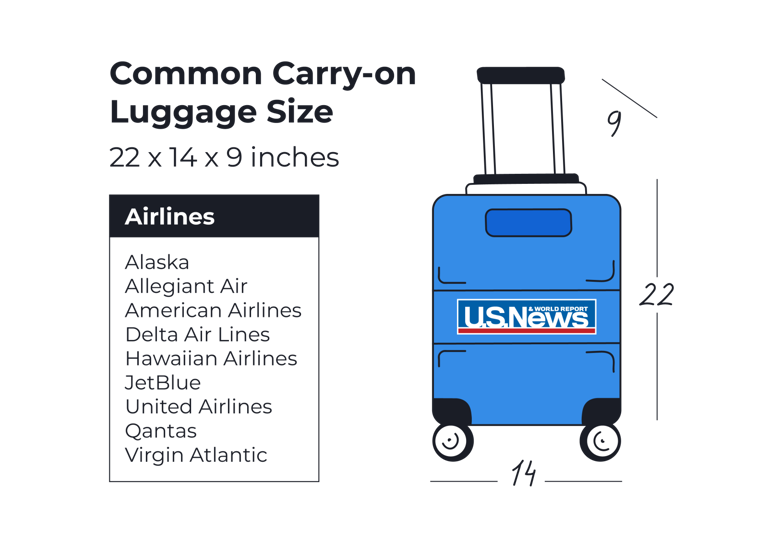
Looks like you're all stocked up!
You’ve reached the purchase limit for this scent kit. don’t worry though, you can still buy up to 3 of each kit.
become a member of the snif fam become a member of the snif fam
Join a community of people obsessed with changing the fragrance experience.
thank you for signing up
There was an error.
By submitting this form, you agree to receive recurring automated promotional and personalized e-mail marketing messages (e.g. cart reminders) from Snif at the mobile number used when signing up. Consent is not a condition of any purchase. Consent is not a condition of any purchase. Reply HELP for help. You can withdraw you consent at any time by texting STOP. Msg frequency varies. Std Msg & data rates may apply. View Terms of Service & Privacy Policy . Contact Snif at [email protected] .
accepted payment methods
- American Express
By using this site you agree to our use of cookies. Read more.

An official website of the United States government
Here’s how you know
Official websites use .gov A .gov website belongs to an official government organization in the United States.
Secure .gov websites use HTTPS A lock ( Lock A locked padlock ) or https:// means you’ve safely connected to the .gov website. Share sensitive information only on official, secure websites.
Liquids Rule
You are allowed to bring a quart-sized bag of liquids, aerosols, gels, creams and pastes in your carry-on bag and through the checkpoint. These are limited to travel-sized containers that are 3.4 ounces (100 milliliters) or less per item. Placing these items in the small bag and separating from your carry-on baggage facilitates the screening process. Pack items that are in containers larger than 3.4 ounces or 100 milliliters in checked baggage.
Any liquid, aerosol, gel, cream or paste that alarms during screening will require additional screening.
- Medications
- Infant and child nourishments
Inbound International Flights
You may carry duty free liquids in secure, tamper–evident bags, more than 3.4 oz or 100 ml in your carry-on bag if:
- The duty free liquids were purchased internationally and you are traveling to the United States with a connecting flight.
- The liquids are packed in a transparent, secure, tamper-evident bag by the retailer and do not show signs of tampering when presented to TSA for screening.
- The original receipt for the liquids is present and the purchase was made within 48 hours.
The items inside the secure, tamper-evident bags must be screened and cleared. Any item that alarms or is unable to be screened will not be permitted in your carry-on bag. We recommend packing all liquids, gels, and aerosols that are over 3.4 oz or 100 ml in your checked baggage, even if they are in a secure, tamper-evident bag.

Everything You Need to Know About the TSA’s Liquid Limit
The tsa allows liquids under 3.4 ounces in your carry-on—but what’s considered a “liquid” isn’t always obvious..
- Copy Link copied

Don’t forget to remove your liquids when going through TSA screening.
Photo by Jaromir Chalabala/Shutterstock
Whether you’re a carry-on-only kind of person or not , knowing the Transportation Security Administration’s (TSA) liquid limits is essential for anyone who travels by plane in the United States. Yet understanding which of your toiletries, foods, and other items even count as “liquid”—let alone how best to pack them—can get confusing. Use this guide to understand the TSA’s rules and restrictions about liquids, common exceptions, and tips to help ensure your next airport security screening goes smoothly.
What is the TSA liquid limit?
The TSA’s liquid limit for carry-ons—known as the 3-1-1 rule—allows travelers to pack liquids, aerosols, gels, creams, and pastes under 3.4 ounces (100 milliliters) in their carry-on bags. Passengers are allowed up to one quart-sized bag per person , or roughly nine 3.4-ounce containers in a single quart-sized bag. Anything more will have to go in a checked bag or risk being tossed out.
If your liquids are stored in containers larger than 3.4 ounces, even if there’s only 3.4 ounces left inside the bottle, you can’t bring them through security.
Completely empty bottles, such as your reusable water bottle , are allowed through the TSA checkpoint since (spoiler alert!) they don’t contain any liquids at that moment.
Which toiletries TSA allows in your carry-on
The TSA allows all of the following common toiletries in your carry-on only in containers that are 3.4 ounces or less:
- Shampoos and conditioners
- Lotions and sunscreen
- Gel hair products
In other words: yes, you can bring toothpaste, deodorant, and sunscreen through TSA checkpoints but only if they are in travel-sized containers.
Powders and powder-like substances, including baby powder and some makeup items, aren’t restricted in your carry-on bag. But if you’re carrying more than 12 ounces (350 milliliters) of a powder, you’ll need to place it in a separate bin for X-ray screening, and it may be subject to additional screening—so it’s a good idea to budget an extra few minutes at the security checkpoint if you think this might happen.
Tips for packing your toiletries in your carry-on

To comply with TSA regulations, invest in small, reusable toiletry bottles, like these capsules by Cadence.
Courtesy of Cadence
Especially if you don’t have TSA PreCheck , it’s helpful to pack all of your toiletries in a quart-sized (or smaller) clear plastic toiletry bag for screening. Although improved airport technology means that far fewer air passengers (both in PreCheck and non-PreCheck lines) will have to take their liquids out out of their carry-on, it’s still helpful to have all of your liquids in one bag just in case you get pulled aside for additional screening. For an upgrade from that large Ziplock, we recommend the standard-sized Clarity Jetset Case from Truffle ($88), which has a clear window panel and is comparable in size to a quart-sized bag.
Since toothpaste is considered a liquid, paste, or gel by the TSA, most of us toss those tiny one-ounce tubes in our carry-on bags. However, if you want to ditch the hard-to-recycle packaging, consider toothpaste tablets, an ecofriendly alternative that’s not subject to the 3-1-1 rule. We like Humankind’s fluoride toothpaste tablets ($12), which resemble small mints and turn to paste when you crush them between your teeth. Matador has also recently released a reusable toothpaste tube ($10), which you can fill (and refill) with your regular toothpaste.
For travel toiletries that are easy to rebottle (like shampoo or body wash), consider investing in reusable bottles or containers so you can always keep your preferred brand on hand. Some of our favorite TSA-approved toiletry bottles include:
Buy Now: GoToob three-pack of 3.4-ounce bottles, $30, rei.com
These easy-to-fill, leakproof silicone tubes are ideal for shampoos, conditioners, lotions, and body washes. GoToob’s line comes in a variety of sizes, ranging from 1.7 to 6 ounces, and are easy to clean between refills.
Matador FlatPack
Buy Now: $13 for one or $35 for three, matadorup.com
Each three-ounce, TSA-approved bottle is made from a durable, waterproof, nylon-based fabric. Like GoToob, they’re leakproof and easy to fill, but thanks to their flexible, fabric-like design, they will shrink to their contents, taking up less space in your pack. >> Read the full review of the Matador FlatPack
Buy Now: $14 for one or $74 for six, keepyourcadence.com
The refillable travel containers by Cadence are small, leakproof “capsules” that click together with magnets. At 0.56 ounces, they’re best for makeup and toiletries you don’t need much of—like a weekend’s worth of shampoo or a week of that under eye cream you only need a dab of.
Foods are subject to liquid limits
The TSA’s 3-1-1 rule applies to food too, meaning you’ll need to make sure any foods that count as liquids, gels, or pastes (like yogurt, peanut butter, pâté, jams, or that tasty pimento cheese spread you tried to bring home from Charleston) are less than 3.4 ounces or packed in your checked bag. There are some exceptions, like frozen foods and juice for babies, and the TSA’s website is the best resource to check for specific items.
Exceptions to TSA’s liquids rule: Full-sized liquids that you can bring through security
The TSA has several important exemptions to its liquids rule. You’re allowed to bring full-sized bottles of the following:
Hand sanitizer: Due to the coronavirus pandemic, the TSA currently allows travelers to bring up to 12 ounces of hand sanitizer in their carry-on bags. These will be screened separately.
Medication: You’re allowed to bring medically necessary liquids, aerosols, and gels through security. This also includes the ice or gel packs you may need to keep your medications cool. You are not required to store these items in a plastic, resealable bag, but you should remove them from your luggage and let the TSA officer know what you’ve packed.
Baby formula and breast milk: Like medication, you can bring freezer packs to keep these items cool, and you should remove them from your luggage and notify an agent when you go through security. More baby-related exceptions? Gel or liquid-filled teethers and canned or jarred baby food.
Of course, the final decision on whether an item is allowed through the checkpoint rests with the TSA officer.
If you’re ever unsure about a specific item, the TSA’s website has a handy, searchable list of prohibited and allowed items worth checking before you travel. You can also now text the TSA with your questions.
This article was originally published in 2022. It has been most recently updated on March 21, 2023, with additional information.

Numbers, Facts and Trends Shaping Your World
Read our research on:
Full Topic List
Regions & Countries
- Publications
- Our Methods
- Short Reads
- Tools & Resources
Read Our Research On:
What we know about unauthorized immigrants living in the U.S.
The unauthorized immigrant population in the United States reached 10.5 million in 2021, according to new Pew Research Center estimates. That was a modest increase over 2019 but nearly identical to 2017.
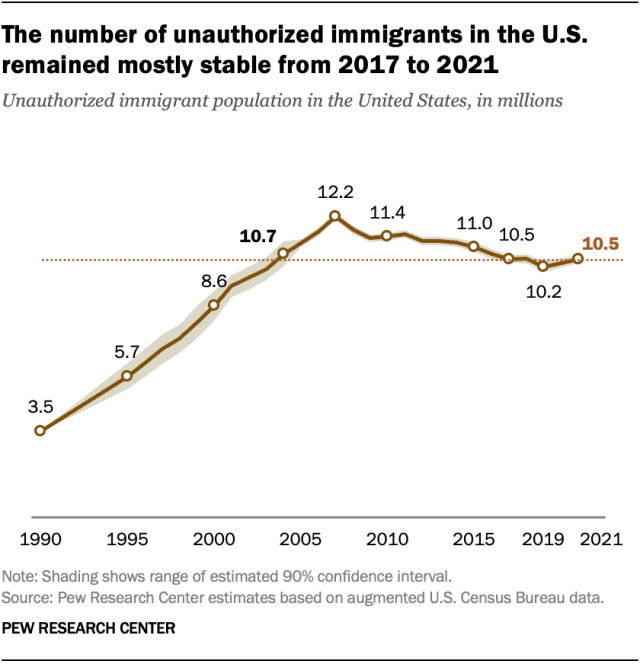
The number of unauthorized immigrants living in the U.S. in 2021 remained below its peak of 12.2 million in 2007. It was about the same size as in 2004 and lower than every year from 2005 to 2015.
The new estimates do not reflect changes that have occurred since apprehensions and expulsions of migrants along the U.S.-Mexico border started increasing in March 2021 . Migrant encounters at the border have since reached historic highs .
Pew Research Center undertook this research to understand ongoing changes in the size and characteristics of the unauthorized immigrant population in the United States. The Center has published estimates of the U.S. unauthorized immigrant population for more than two decades. The estimates presented in this research are the Center’s latest, adding new and updated annual estimates for 2017 through 2021.
Center estimates of the unauthorized immigrant population use a “residual method.” It is similar to methods used by the U.S. Department of Homeland Security’s Office of Immigration Statistics and nongovernmental organizations, including the Center for Migration Studies and the Migration Policy Institute . Those organizations’ estimates are generally consistent with ours. Our estimates also align with official U.S. data sources, including birth records, school enrollment figures and tax data, as well as Mexican censuses and surveys.
Our “residual” method for estimating the nation’s unauthorized immigrant population includes these steps:
- Estimate the total number of immigrants living in the country in a particular year using data from U.S. censuses and government surveys such as the American Community Survey and the Current Population Survey.
- Estimate the number of immigrants living in the U.S. legally using official counts of immigrant and refugee admissions together with other demographic data (for example, death and out-migration rates).
- Subtract our estimate of lawful immigrants from our estimate of the total immigrant population . This provides an initial estimate of the unauthorized immigrant population .
Our final estimate of the U.S. unauthorized immigrant population, as well as estimates for lawful immigrants, includes an upward adjustment. We do this because censuses and surveys tend to miss some people . Undercounts for immigrants, especially unauthorized immigrants, tend to be higher than for other groups. (Our 1990 estimate comes from work by Robert Warren and John Robert Warren; details can be found here .)
The term “unauthorized immigrant” reflects standard and customary usage by many academic researchers and policy analysts. The U.S. Department of Homeland Security’s Office of Immigration Statistics also generally uses it. The term means the same thing as undocumented immigrants, illegal immigrants and illegal aliens.
For more details on how we produced our estimates, read the Methodology section of our November 2018 report on unauthorized immigrants.
The unauthorized immigrant population includes any immigrants not in the following groups:
- Immigrants admitted for lawful residence (i.e., green card admissions)
- People admitted formally as refugees
- People granted asylum
- Former unauthorized immigrants granted legal residence under the 1985 Immigration Reform and Control Act
- Immigrants admitted under any of categories 1-4 who have become naturalized U.S. citizens
- Individuals admitted as lawful temporary residents under specific visa categories
Read the Methodology section of our November 2018 report on unauthorized immigrants for more details.
Pew Research Center’s estimate of unauthorized immigrants includes more than 2 million immigrants who have temporary permission to be in the United States. (Some also have permission to work in the country.) These immigrants account for about 20% of our national estimate of 10.5 million unauthorized immigrants for 2021.
Although these immigrants have permission to be in the country, they could be subject to deportation if government policy changes. Other organizations and the federal government also include these immigrants in their estimates of the U.S. unauthorized immigrant population.
Immigrants can receive temporary permission to be in the U.S. through the following ways:
Temporary Protected Status (TPS)
In 2021, there were about 500,000 unauthorized immigrants with Temporary Protected Status . This status provides protection from removal or deportation to individuals who cannot safely return to their country because of civil unrest, violence or natural disaster.
Deferred Enforced Departure (DED) is a similar program that grants protection from removal. The number of immigrants with DED is much smaller than the number with TPS.
Deferred Action for Childhood Arrivals (DACA)
Deferred Action for Childhood Arrivals is a program that offers protection from deportation to individuals who were brought to the U.S. as children before June 15, 2007. As of the end of 2021, there were slightly more than 600,000 DACA beneficiaries , largely immigrants from Mexico.
Asylum applicants
Individuals who have applied for asylum but are awaiting a ruling are not legal residents yet but cannot be deported. There are two types of asylum claims, defensive and affirmative .
Defensive asylum applications are generally filed by individuals facing deportation or removal from the U.S. These are processed by the Department of Justice’s Executive Office for Immigration Review. At the end of 2021, there were almost 600,000 applications pending.
Affirmative asylum claims are made by individuals already in the U.S. who are not in the process of being deported or removed. These claims are handled by the U.S. Department of Homeland Security’s Citizenship and Immigration Services (USCIS). At the end of 2021, more than 400,000 applications for affirmative asylum were pending, some covering more than one applicant.
Here are key findings about how the U.S. unauthorized immigrant population changed from 2017 to 2021:
- The most common country of birth for unauthorized immigrants is Mexico. However, the population of unauthorized immigrants from Mexico dropped by 900,000 from 2017 to 2021 , to 4.1 million.
- There were increases in unauthorized immigrants from nearly every other region of the world – Central America, the Caribbean, South America, Asia, Europe and sub-Saharan Africa.
- Among U.S. states, only Florida and Washington saw increases to their unauthorized immigrant populations , while California and Nevada saw decreases. In all other states, unauthorized immigrant populations were unchanged.
- 4.6% of U.S. workers in 2021 were unauthorized immigrants , virtually identical to the share in 2017.
Trends in the U.S. immigrant population
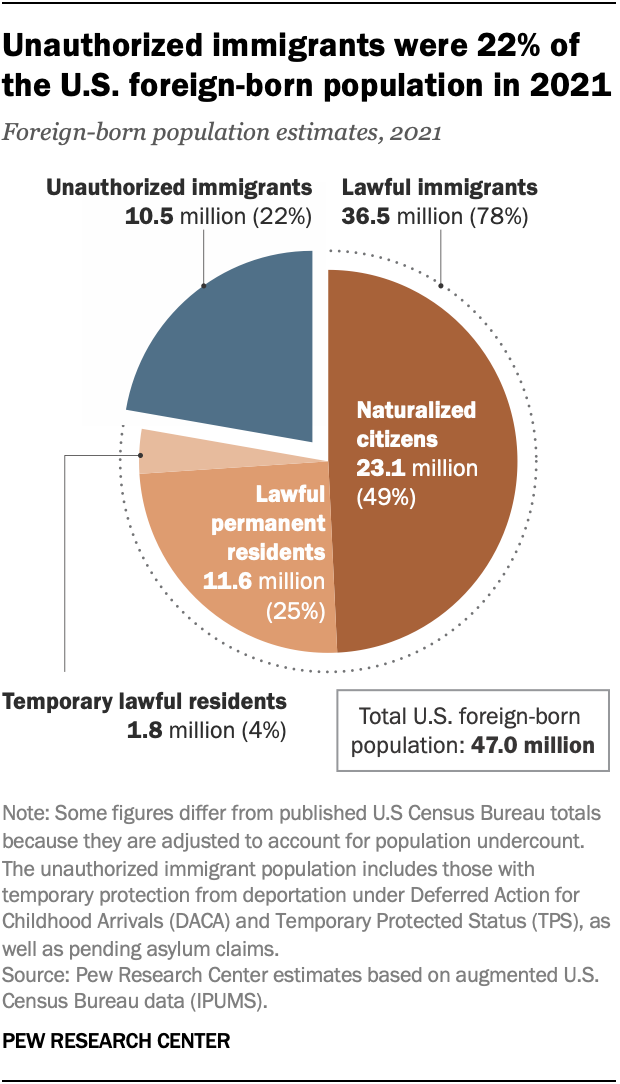
The U.S. foreign-born population was 14.1% of the nation’s population in 2021. That was very slightly higher than in the last five years but below the record high of 14.8% in 1890.
As of 2021, the nation’s 10.5 million unauthorized immigrants represented about 3% of the total U.S. population and 22% of the foreign-born population. These shares were among the lowest since the 1990s.
Between 2007 and 2021, the unauthorized immigrant population decreased by 1.75 million, or 14%.
Meanwhile, the lawful immigrant population grew by more than 8 million, a 29% increase, and the number of naturalized U.S. citizens grew by 49%. In 2021, naturalized citizens accounted for about half (49%) of all immigrants in the country.
Where unauthorized immigrants come from
Unauthorized immigrants living in the U.S. come from many parts of the world, with Mexico being the most common origin country.
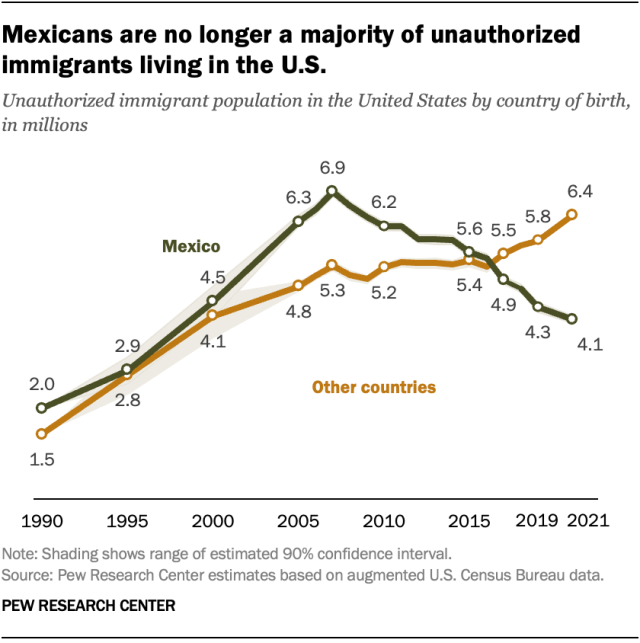
The origin countries for unauthorized immigrants have changed since the population peaked in 2007, before the Great Recession slowed immigration. Here are some highlights of those changes:
The number of unauthorized immigrants from Mexico living in the U.S. (4.1 million in 2021) was the lowest since the 1990s. Mexico accounted for 39% of the nation’s unauthorized immigrants in 2021, by far the smallest share on record .
The decrease in unauthorized immigrants from Mexico reflects several factors:
- A broader decline in migration from Mexico to the U.S.
- Mexican immigrants to the U.S. continuing to return to Mexico
- Expanded opportunities for lawful immigration from Mexico and other countries, especially for temporary agricultural workers.
The rest of the world
The total number of unauthorized immigrants in the U.S. from countries other than Mexico has grown rapidly. In 2021, this population was 6.4 million, up by 900,000 from 2017.
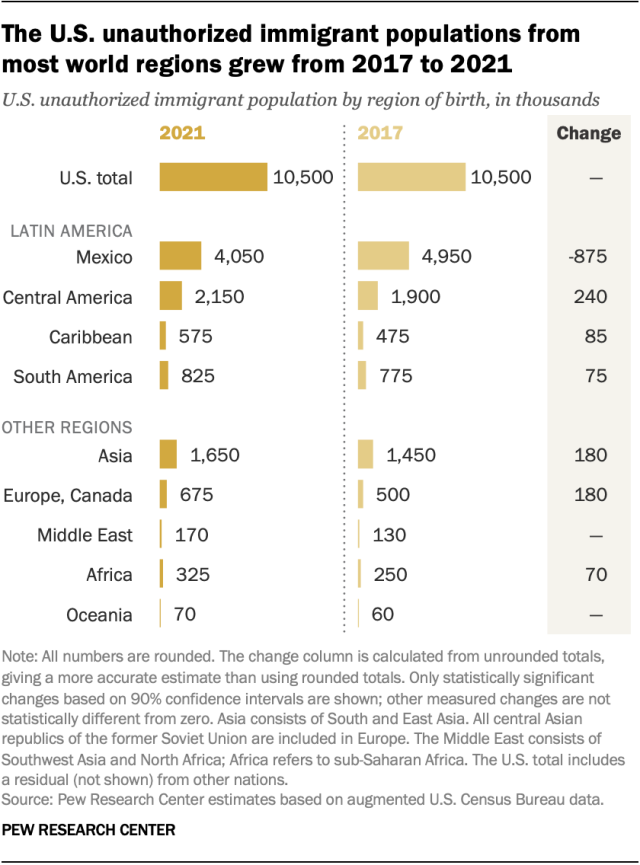
Almost every region in the world had a notable increase in the number of unauthorized immigrants in the U.S. from 2007 to 2021. The largest increases were from Central America (240,000) and South and East Asia (180,000).
After Mexico, the countries of origin with the largest unauthorized immigrant populations in the U.S. in 2021 were:
- El Salvador (800,000)
- India (725,000)
- Guatemala (700,000)
- Honduras (525,000)
India, Guatemala and Honduras all saw increases from 2017.
The Northern Triangle
Three Central American countries – El Salvador, Honduras and Guatemala – together represented 2.0 million unauthorized immigrants in the U.S. in 2021, or almost 20% of the total. The unauthorized immigrant population from the Northern Triangle grew by about 250,000 from 2017 and about 700,000 from 2007.
Other origin countries
Venezuela was the country of birth for 190,000 U.S. unauthorized immigrants in 2021. This population saw particularly fast growth, from 130,000 in 2017 and 55,000 in 2007.
Among countries with the largest numbers of U.S. unauthorized immigrants, India, Brazil, Canada and former Soviet Union countries all experienced growth from 2017 to 2021.
Some origin countries with significant unauthorized immigrant populations showed no change, notably China (375,000) and the Dominican Republic (230,000).
Detailed table: Unauthorized immigrant population by region and selected country of birth (and margins of error), 1990-2021 (Excel)
U.S. states of residence of unauthorized immigrants
The unauthorized immigrant population in most U.S. states stayed steady from 2017 to 2021. However, four states saw significant changes:
- Florida (+80,000)
- Washington (+60,000)
- California (-150,000)
- Nevada (-25,000)
States with the most unauthorized immigrants
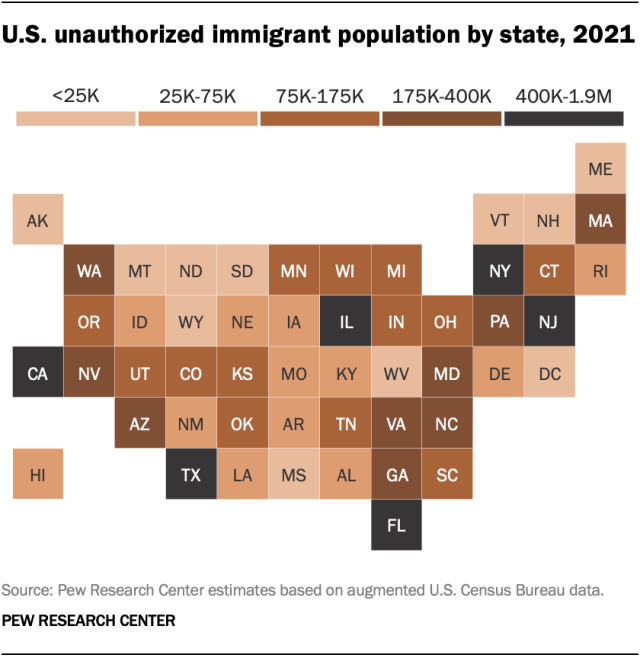
The six states with the largest unauthorized immigrant populations in 2021 were:
- California (1.9 million)
- Texas (1.6 million)
- Florida (900,000)
- New York (600,000)
- New Jersey (450,000)
- Illinois (400,000)
These states have consistently had the most unauthorized immigrants since 1990 and earlier .
At the same time, the unauthorized immigrant population has become less geographically concentrated. In 2021, these six states were home to 56% of the nation’s unauthorized immigrants, down from 80% in 1990.
Detailed table: Unauthorized immigrant population for states (and margins of error), 1990-2021 (Excel)
Detailed table: Unauthorized immigrants and characteristics for states, 2021 (Excel)
Unauthorized immigrants in the labor force
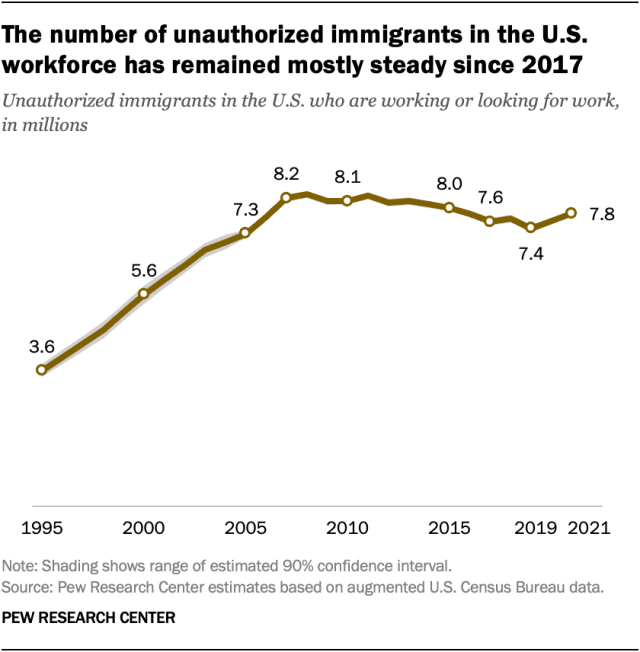
The share of unauthorized immigrants in the U.S. workforce was slightly less than 5% in 2021, compared with 3% of the total U.S. population.
Demographics help explain the difference: The unauthorized immigrant population includes relatively few children or elderly adults, groups that tend not to be in the labor force.
Overall, about 7.8 million unauthorized immigrants were in the U.S. labor force in 2021. That was up slightly from 2019 but smaller than every year from 2007 through 2015.
Detailed table: Unauthorized immigrants in the labor force for states, 2021 (Excel)
Here are some additional findings about unauthorized immigrants as a share of the workforce nationwide and in certain states:
- Since 2003, unauthorized immigrants have made up 4.4% to 5.4% of all U.S. workers, a relatively narrow range.
- Fewer than 1% of workers in Maine, Montana, Vermont and West Virginia in 2021 were unauthorized immigrants.
- Nevada (9%) and Texas (8%) had the highest shares of unauthorized immigrants in the workforce.
- Immigrant Populations
- Immigration Issues
- Unauthorized Immigration

Jeffrey S. Passel is a senior demographer at Pew Research Center

Jens Manuel Krogstad is a senior writer and editor at Pew Research Center
Key facts about Asian Americans living in poverty
Latinos’ views on the migrant situation at the u.s.-mexico border, key facts about the nation’s 47.9 million black americans, key facts about the wealth of immigrant households during the covid-19 pandemic, 8 facts about recent latino immigrants to the u.s., most popular.
1615 L St. NW, Suite 800 Washington, DC 20036 USA (+1) 202-419-4300 | Main (+1) 202-857-8562 | Fax (+1) 202-419-4372 | Media Inquiries
Research Topics
- Age & Generations
- Coronavirus (COVID-19)
- Economy & Work
- Family & Relationships
- Gender & LGBTQ
- Immigration & Migration
- International Affairs
- Internet & Technology
- Methodological Research
- News Habits & Media
- Non-U.S. Governments
- Other Topics
- Politics & Policy
- Race & Ethnicity
- Email Newsletters
ABOUT PEW RESEARCH CENTER Pew Research Center is a nonpartisan fact tank that informs the public about the issues, attitudes and trends shaping the world. It conducts public opinion polling, demographic research, media content analysis and other empirical social science research. Pew Research Center does not take policy positions. It is a subsidiary of The Pew Charitable Trusts .
Copyright 2024 Pew Research Center
Terms & Conditions
Privacy Policy
Cookie Settings
Reprints, Permissions & Use Policy

Turn Your Curiosity Into Discovery
Latest facts.
11 Facts About National Love Your Produce Manager Day April 2nd
10 Facts About National Clean Out Your Medicine Cabinet Day April 19th
40 facts about elektrostal.
Written by Lanette Mayes
Modified & Updated: 02 Mar 2024
Reviewed by Jessica Corbett

Elektrostal is a vibrant city located in the Moscow Oblast region of Russia. With a rich history, stunning architecture, and a thriving community, Elektrostal is a city that has much to offer. Whether you are a history buff, nature enthusiast, or simply curious about different cultures, Elektrostal is sure to captivate you.
This article will provide you with 40 fascinating facts about Elektrostal, giving you a better understanding of why this city is worth exploring. From its origins as an industrial hub to its modern-day charm, we will delve into the various aspects that make Elektrostal a unique and must-visit destination.
So, join us as we uncover the hidden treasures of Elektrostal and discover what makes this city a true gem in the heart of Russia.
Key Takeaways:
- Elektrostal, known as the “Motor City of Russia,” is a vibrant and growing city with a rich industrial history, offering diverse cultural experiences and a strong commitment to environmental sustainability.
- With its convenient location near Moscow, Elektrostal provides a picturesque landscape, vibrant nightlife, and a range of recreational activities, making it an ideal destination for residents and visitors alike.
Known as the “Motor City of Russia.”
Elektrostal, a city located in the Moscow Oblast region of Russia, earned the nickname “Motor City” due to its significant involvement in the automotive industry.
Home to the Elektrostal Metallurgical Plant.
Elektrostal is renowned for its metallurgical plant, which has been producing high-quality steel and alloys since its establishment in 1916.
Boasts a rich industrial heritage.
Elektrostal has a long history of industrial development, contributing to the growth and progress of the region.
Founded in 1916.
The city of Elektrostal was founded in 1916 as a result of the construction of the Elektrostal Metallurgical Plant.
Located approximately 50 kilometers east of Moscow.
Elektrostal is situated in close proximity to the Russian capital, making it easily accessible for both residents and visitors.
Known for its vibrant cultural scene.
Elektrostal is home to several cultural institutions, including museums, theaters, and art galleries that showcase the city’s rich artistic heritage.
A popular destination for nature lovers.
Surrounded by picturesque landscapes and forests, Elektrostal offers ample opportunities for outdoor activities such as hiking, camping, and birdwatching.
Hosts the annual Elektrostal City Day celebrations.
Every year, Elektrostal organizes festive events and activities to celebrate its founding, bringing together residents and visitors in a spirit of unity and joy.
Has a population of approximately 160,000 people.
Elektrostal is home to a diverse and vibrant community of around 160,000 residents, contributing to its dynamic atmosphere.
Boasts excellent education facilities.
The city is known for its well-established educational institutions, providing quality education to students of all ages.
A center for scientific research and innovation.
Elektrostal serves as an important hub for scientific research, particularly in the fields of metallurgy, materials science, and engineering.
Surrounded by picturesque lakes.
The city is blessed with numerous beautiful lakes, offering scenic views and recreational opportunities for locals and visitors alike.
Well-connected transportation system.
Elektrostal benefits from an efficient transportation network, including highways, railways, and public transportation options, ensuring convenient travel within and beyond the city.
Famous for its traditional Russian cuisine.
Food enthusiasts can indulge in authentic Russian dishes at numerous restaurants and cafes scattered throughout Elektrostal.
Home to notable architectural landmarks.
Elektrostal boasts impressive architecture, including the Church of the Transfiguration of the Lord and the Elektrostal Palace of Culture.
Offers a wide range of recreational facilities.
Residents and visitors can enjoy various recreational activities, such as sports complexes, swimming pools, and fitness centers, enhancing the overall quality of life.
Provides a high standard of healthcare.
Elektrostal is equipped with modern medical facilities, ensuring residents have access to quality healthcare services.
Home to the Elektrostal History Museum.
The Elektrostal History Museum showcases the city’s fascinating past through exhibitions and displays.
A hub for sports enthusiasts.
Elektrostal is passionate about sports, with numerous stadiums, arenas, and sports clubs offering opportunities for athletes and spectators.
Celebrates diverse cultural festivals.
Throughout the year, Elektrostal hosts a variety of cultural festivals, celebrating different ethnicities, traditions, and art forms.
Electric power played a significant role in its early development.
Elektrostal owes its name and initial growth to the establishment of electric power stations and the utilization of electricity in the industrial sector.
Boasts a thriving economy.
The city’s strong industrial base, coupled with its strategic location near Moscow, has contributed to Elektrostal’s prosperous economic status.
Houses the Elektrostal Drama Theater.
The Elektrostal Drama Theater is a cultural centerpiece, attracting theater enthusiasts from far and wide.
Popular destination for winter sports.
Elektrostal’s proximity to ski resorts and winter sport facilities makes it a favorite destination for skiing, snowboarding, and other winter activities.
Promotes environmental sustainability.
Elektrostal prioritizes environmental protection and sustainability, implementing initiatives to reduce pollution and preserve natural resources.
Home to renowned educational institutions.
Elektrostal is known for its prestigious schools and universities, offering a wide range of academic programs to students.
Committed to cultural preservation.
The city values its cultural heritage and takes active steps to preserve and promote traditional customs, crafts, and arts.
Hosts an annual International Film Festival.
The Elektrostal International Film Festival attracts filmmakers and cinema enthusiasts from around the world, showcasing a diverse range of films.
Encourages entrepreneurship and innovation.
Elektrostal supports aspiring entrepreneurs and fosters a culture of innovation, providing opportunities for startups and business development.
Offers a range of housing options.
Elektrostal provides diverse housing options, including apartments, houses, and residential complexes, catering to different lifestyles and budgets.
Home to notable sports teams.
Elektrostal is proud of its sports legacy, with several successful sports teams competing at regional and national levels.
Boasts a vibrant nightlife scene.
Residents and visitors can enjoy a lively nightlife in Elektrostal, with numerous bars, clubs, and entertainment venues.
Promotes cultural exchange and international relations.
Elektrostal actively engages in international partnerships, cultural exchanges, and diplomatic collaborations to foster global connections.
Surrounded by beautiful nature reserves.
Nearby nature reserves, such as the Barybino Forest and Luchinskoye Lake, offer opportunities for nature enthusiasts to explore and appreciate the region’s biodiversity.
Commemorates historical events.
The city pays tribute to significant historical events through memorials, monuments, and exhibitions, ensuring the preservation of collective memory.
Promotes sports and youth development.
Elektrostal invests in sports infrastructure and programs to encourage youth participation, health, and physical fitness.
Hosts annual cultural and artistic festivals.
Throughout the year, Elektrostal celebrates its cultural diversity through festivals dedicated to music, dance, art, and theater.
Provides a picturesque landscape for photography enthusiasts.
The city’s scenic beauty, architectural landmarks, and natural surroundings make it a paradise for photographers.
Connects to Moscow via a direct train line.
The convenient train connection between Elektrostal and Moscow makes commuting between the two cities effortless.
A city with a bright future.
Elektrostal continues to grow and develop, aiming to become a model city in terms of infrastructure, sustainability, and quality of life for its residents.
In conclusion, Elektrostal is a fascinating city with a rich history and a vibrant present. From its origins as a center of steel production to its modern-day status as a hub for education and industry, Elektrostal has plenty to offer both residents and visitors. With its beautiful parks, cultural attractions, and proximity to Moscow, there is no shortage of things to see and do in this dynamic city. Whether you’re interested in exploring its historical landmarks, enjoying outdoor activities, or immersing yourself in the local culture, Elektrostal has something for everyone. So, next time you find yourself in the Moscow region, don’t miss the opportunity to discover the hidden gems of Elektrostal.
Q: What is the population of Elektrostal?
A: As of the latest data, the population of Elektrostal is approximately XXXX.
Q: How far is Elektrostal from Moscow?
A: Elektrostal is located approximately XX kilometers away from Moscow.
Q: Are there any famous landmarks in Elektrostal?
A: Yes, Elektrostal is home to several notable landmarks, including XXXX and XXXX.
Q: What industries are prominent in Elektrostal?
A: Elektrostal is known for its steel production industry and is also a center for engineering and manufacturing.
Q: Are there any universities or educational institutions in Elektrostal?
A: Yes, Elektrostal is home to XXXX University and several other educational institutions.
Q: What are some popular outdoor activities in Elektrostal?
A: Elektrostal offers several outdoor activities, such as hiking, cycling, and picnicking in its beautiful parks.
Q: Is Elektrostal well-connected in terms of transportation?
A: Yes, Elektrostal has good transportation links, including trains and buses, making it easily accessible from nearby cities.
Q: Are there any annual events or festivals in Elektrostal?
A: Yes, Elektrostal hosts various events and festivals throughout the year, including XXXX and XXXX.
Was this page helpful?
Our commitment to delivering trustworthy and engaging content is at the heart of what we do. Each fact on our site is contributed by real users like you, bringing a wealth of diverse insights and information. To ensure the highest standards of accuracy and reliability, our dedicated editors meticulously review each submission. This process guarantees that the facts we share are not only fascinating but also credible. Trust in our commitment to quality and authenticity as you explore and learn with us.
Share this Fact:
Firebird Travel
RUSSIA TRAVEL HOME
Thank you for your enquiry.
RUSSIA TRAVEL PACKAGES A selection of Russian tours to take as they are or adjust to your needs.
THE GOLDEN RING Visit the heart of ancient Russia. What is the Golden Ring?
MOSCOW TOURS What you can see in Moscow.
MOSCOW DAY TRIPS Get out of Moscow and take a relaxing trip to some of these places
ST. PETERSBURG Some of the sights to see in Petersburg
LAKE BAIKAL TOURS Hiking and trekking around the world's deepest lake in the heart of Siberia
RUSSIAN DIGS Come and work in the field on a Russian Archaeological dig. Full training given on site.
TRAVEL TIPS & SERVICES Getting around in Russia
If you do not receive a confirmation email shortly then you have probably incorrectly entered your email.
Number of travelers ">
Special Interests or requests. "> ">
If you experience difficulties please use this link to send Regular Email . All information is treated as confidential

IMAGES
COMMENTS
Most commonly, checked luggage will have a size restriction of 62 linear inches (height + width + length) and a weight limit of 50 or 70 lbs. These are the IATA guidelines that are enforced in the EU and US which are there to keep the baggage handlers from handling too heavy bags.
Carry-on luggage size: 21.5 x 15.5 x 9 inches for a standard carry-on bag, or 22 x 21 x 6 inches for a folding garment bag: Carry-on luggage weight limit: 17.5 pounds: Personal item size: 15.5 x ...
Economy class x 1 bag. Domestic flights: 21.7 x 15.7 x 7.9 inches. (55 x 40 x 20 cm) International or regional flights: maximum linear dimensions 45 inches (115 cm) Domestic flights: 15 pounds (7 kg) International or regional flights: 22 pounds (10 kg) U.S. departures: 22 pounds (10 kg)
The standard carry-on size for international carriers is slightly smaller than that of the U.S., measuring overall at 21.7 by 15.7 by 9 inches, including handles and wheels. Here are the carry-on policies for economy passengers on major international carriers: Air Canada: 21.5 by 15 by 9 inches. British Airways: 22 by 18 by 10 inches.
Shop Colgate Total Travel Size Whitening Paste Toothpaste - Trial Size - 1.4oz at Target. Choose from Same Day Delivery, Drive Up or Order Pickup. Free standard shipping with $35 orders.
The fees can go as high as $70 per bag, though, depending on where and when you're traveling. Personal item: 18 x 14 x 8 inches, free. Carry-on: 22 x 16 x 10 inches, starting at $28 and weighing ...
E.g., United Airlines allows up to 165 lbs (75 kg) for musical instruments and 100 lbs (45 kg) for assistive devices. Oversized bags (bigger than 62 linear inches) might be subject to extra charges. Packing weight is often a more crucial concern for larger bags. Airlines now rigorously enforce weight and size limits.
Carry On Bag Size and Dimensions. Domestic flights follow similar guidelines for carry on dimensions: roughly 22x14x9 inches. Check out our rundown of maximum carry-on sizes by airline to ensure you meet the TSA carry on size limits. When you're heading overseas, there are different rules to follow. International flights have different ...
Most airlines allow: 1 carry-on baggage, 1 personal item (backpack, purse, laptop bag), and 1 to 2 checked bags. There is usually a max weight and size restriction. The most common maximum size bag allowed is 62 linear (total) inches. A common size bag for checking through is: 27" x 21" x 14".
Personal item size: 15.7 x 11.8 x 5.8 inches. Personal item maximum weight: 26.4 to 40 lbs (fare dependent) including carry-on luggage. Note: If you're traveling with Air France on an Economy ticket, you can take one carry-on and a personal item with a combined weight of 26.4 lbs.
Maximum of 80 inches (length + width + height). 50 pounds. Alaska Airlines. Maximum of 62 inches (length + width + height). 50 pounds. American Airlines. Maximum of 62 inches (length + width ...
The 3-1-1 Rule refers to three core components that govern how many liquids you can bring in your carry-on bags: Each liquid must be in a 3.4-ounce or less container ("3"), all containers must be placed inside one clear quart-sized plastic bag ("1"), and each passenger is only allowed one plastic bag ("1"). In sum, the 3-1-1 Rule states that ...
personal and carryon items. Personal items must fit in the 16.25 x 13.5 x 8 inch. space under the seat. 24 x 16 x 10 inches. If you travel on multiple airlines on a regular basis, opt forcarry-on bags designed to meet most airlines size restrictions, such as the Travelpro®Platinum® Elite 21" Expandable Carry-On Spinner or theMaxlite® Air ...
International luggage sizes are just as important as weight limits when choosing your travel luggage. Size restrictions for international airlines may be expressed in inches or centimeters by height, width, and depth. ... 62 total linear: 15.4: Scandinavian Airlines: 21.7 x 15.7 x 9: 17.6: Singapore Airlines: 45.3 total linear: 15.4:
Carry-on luggage size. 21.5 x 15.5 x 9 inches for. a standard carry-on bag, or 22 x 21 x 6 inches for. a folding garment bag. Carry-on luggage weight limit. 17.5 pounds. Personal item size. 15.5 x ...
According to the Transportation Security Administration (TSA), "travel size" refers to any liquid that is 3.4 ounces (100 milliliters) or less. In other words, these are small liquids that can easily and safely be thrown into your bag. The TSA has a liquid limit for carry-on baggage known as the 3-1-1 liquids rule.
Liquids Rule. Liquids Rule. You are allowed to bring a quart-sized bag of liquids, aerosols, gels, creams and pastes in your carry-on bag and through the checkpoint. These are limited to travel-sized containers that are 3.4 ounces (100 milliliters) or less per item. Placing these items in the small bag and separating from your carry-on baggage ...
Singapore Airlines states that the total dimensions (length plus width plus height) of your carry-on bag must not exceed 45 inches, and carry-ons have a maximum weight of 15.4 pounds.
The TSA's liquid limit for carry-ons—known as the 3-1-1 rule—allows travelers to pack liquids, aerosols, gels, creams, and pastes under 3.4 ounces (100 milliliters) in their carry-on bags. Passengers are allowed up to one quart-sized bag per person, or roughly nine 3.4-ounce containers in a single quart-sized bag.
Colgate Total Travel Size Whitening Paste Toothpaste - Trial Size - 1.4oz. Colgate. 1127. $1.99( $1.42 /ounce) When purchased online. Add to cart. Colgate Optic White Advanced Whitening Toothpaste with Fluoride, 2% Hydrogen Peroxide - Sparkling White - 3.2oz. Colgate.
It almost feels personal, coming from the Barnard administration. It feels vindictive, it feels malicious and mean," Haider said. "I mean, there's no reason to give a student 15 minutes to gather up their possessions. …. If you want to suspend them and you want to go through process, it's one thing, but the lack of humanity that is ...
Moscow, city, capital of Russia, located in the far western part of the country.Since it was first mentioned in the chronicles of 1147, Moscow has played a vital role in Russian history. It became the capital of Muscovy (the Grand Principality of Moscow) in the late 13th century; hence, the people of Moscow are known as Muscovites.Today Moscow is not only the political centre of Russia but ...
The total number of unauthorized immigrants in the U.S. from countries other than Mexico has grown rapidly. In 2021, this population was 6.4 million, up by 900,000 from 2017. Almost every region in the world had a notable increase in the number of unauthorized immigrants in the U.S. from 2007 to 2021.
Elektrostal is linked by Elektrichka suburban electric trains to Moscow's Kursky Rail Terminal with a travel time of 1 hour and 20 minutes. Long distance buses link Elektrostal to Noginsk, Moscow and other nearby towns. Local public transport includes buses. Sports
40 Facts About Elektrostal. Elektrostal is a vibrant city located in the Moscow Oblast region of Russia. With a rich history, stunning architecture, and a thriving community, Elektrostal is a city that has much to offer. Whether you are a history buff, nature enthusiast, or simply curious about different cultures, Elektrostal is sure to ...
MOSCOW DAY TRIPS Get out of Moscow and take a relaxing trip to some of these places. ST. PETERSBURG Some of the sights to see in Petersburg. LAKE BAIKAL TOURS